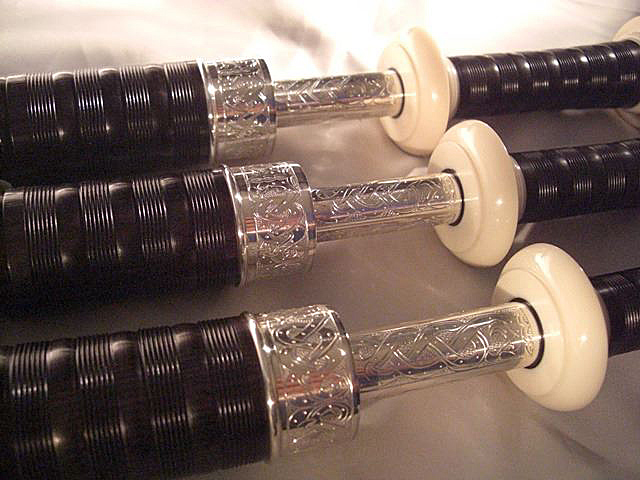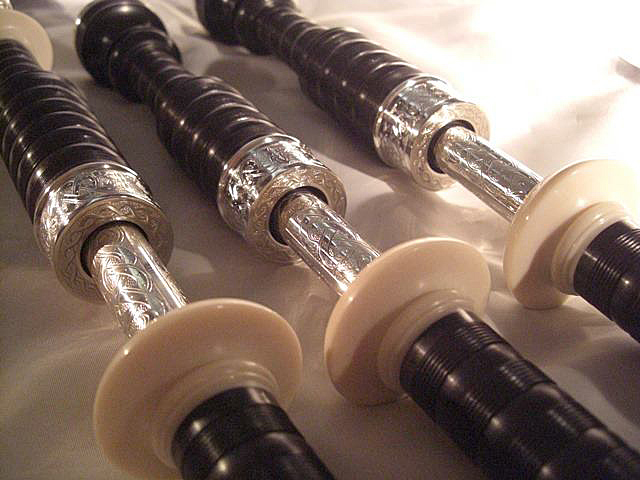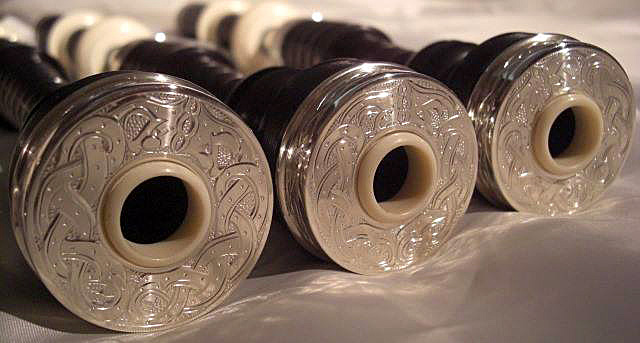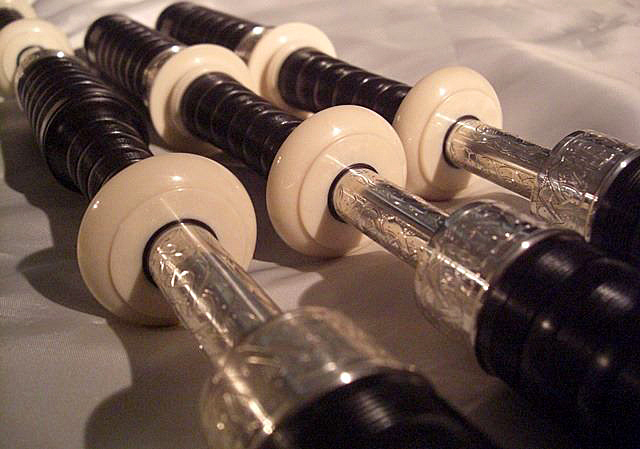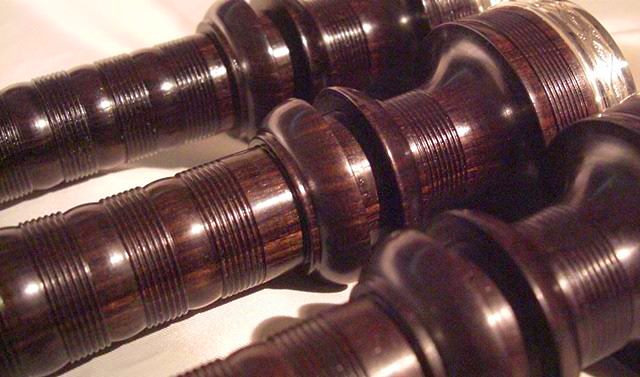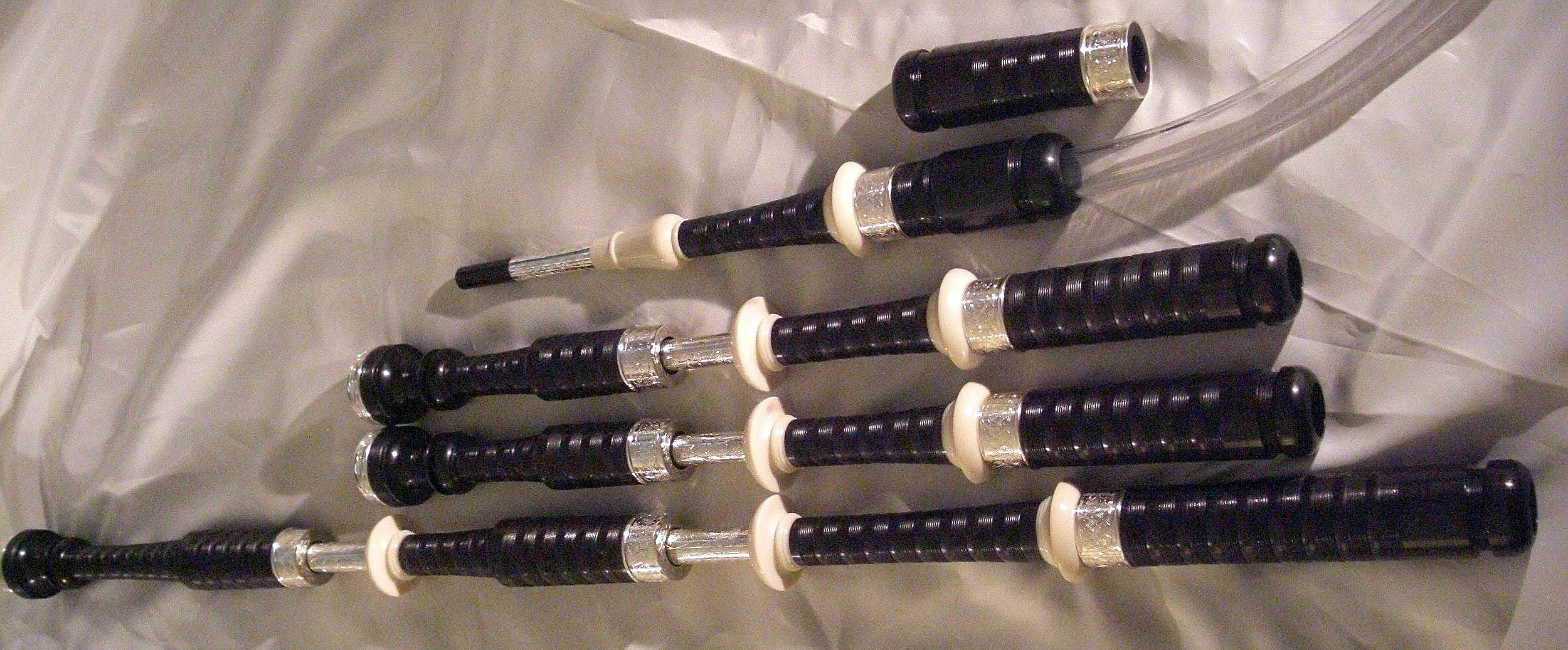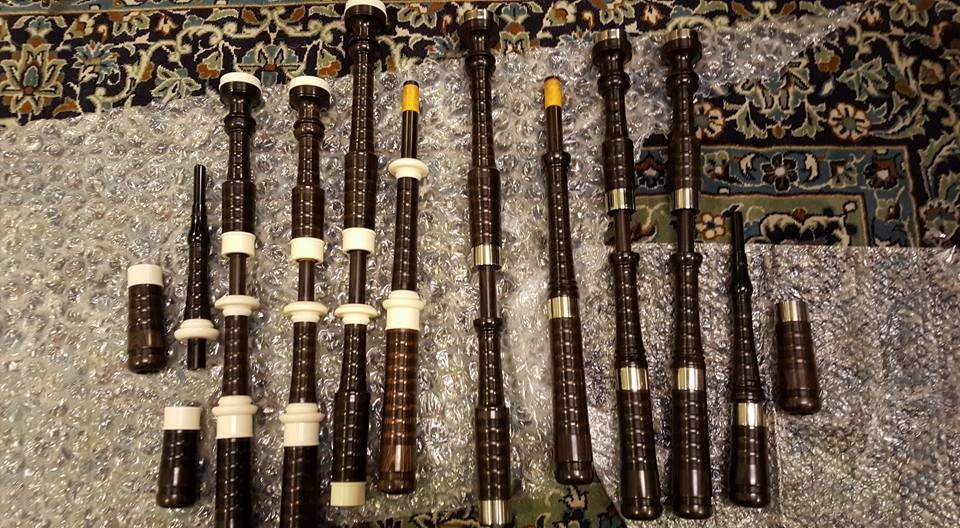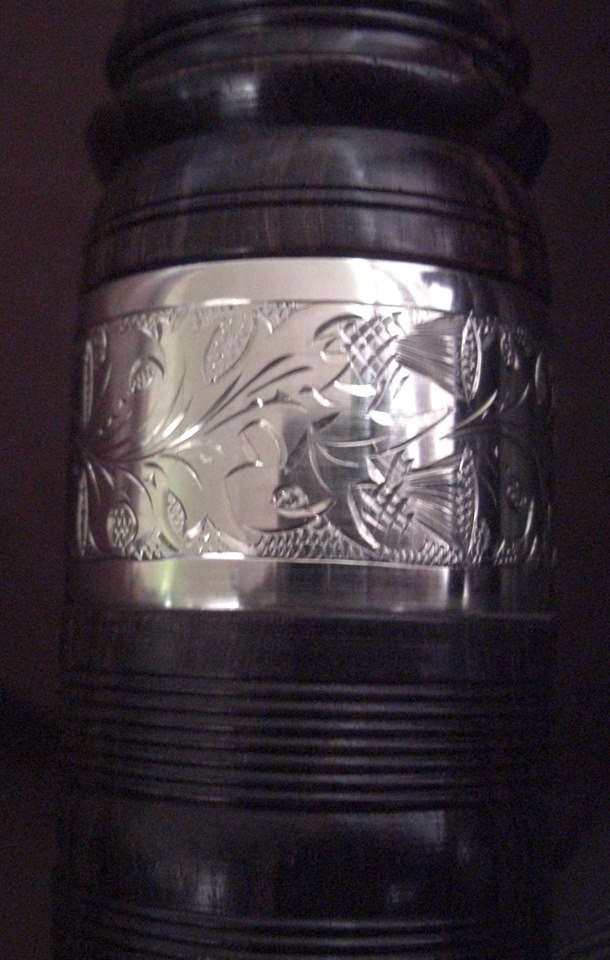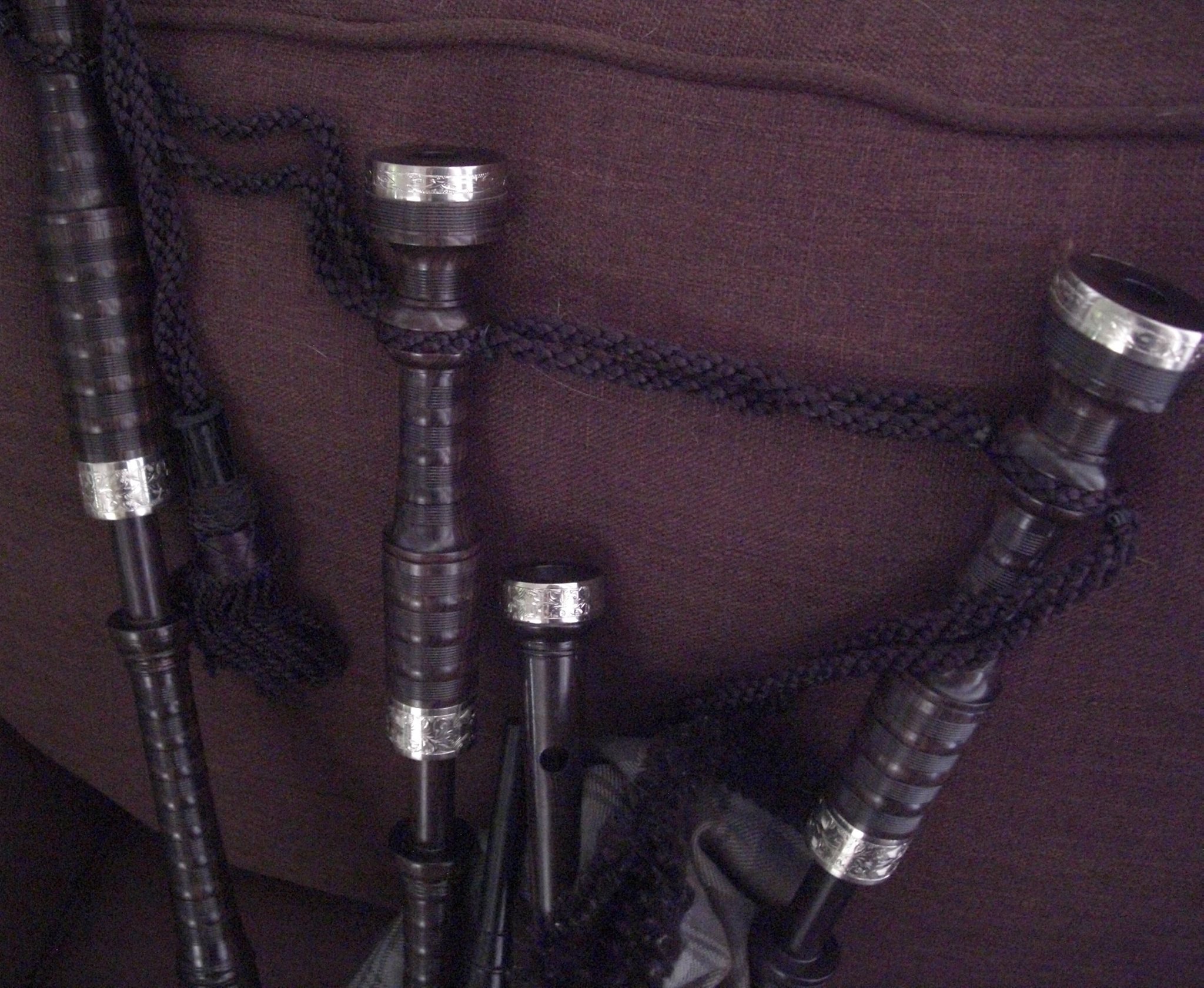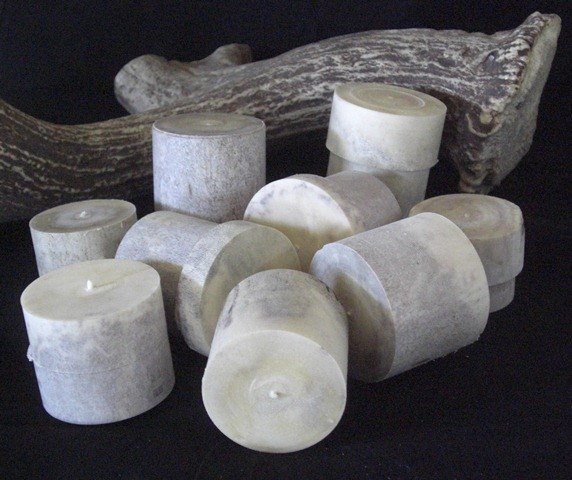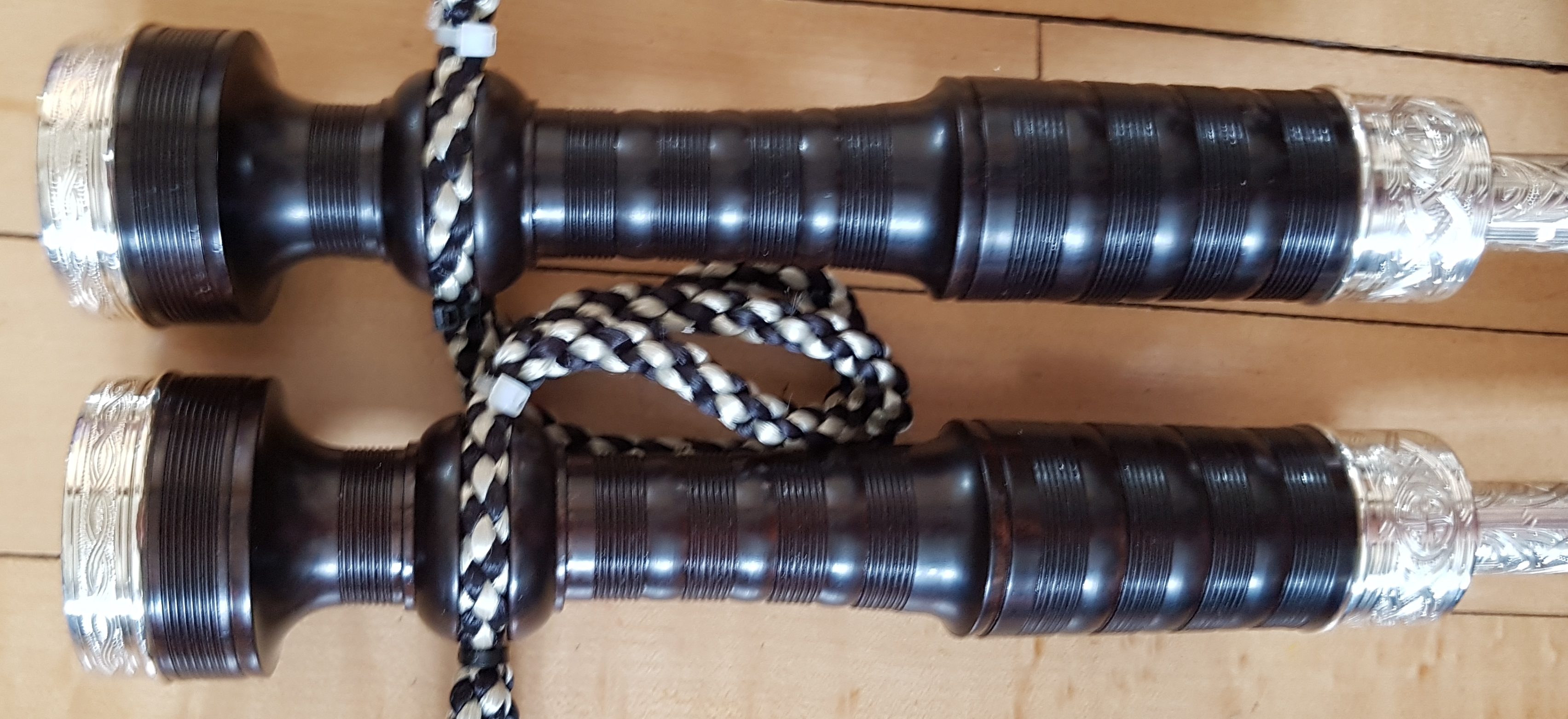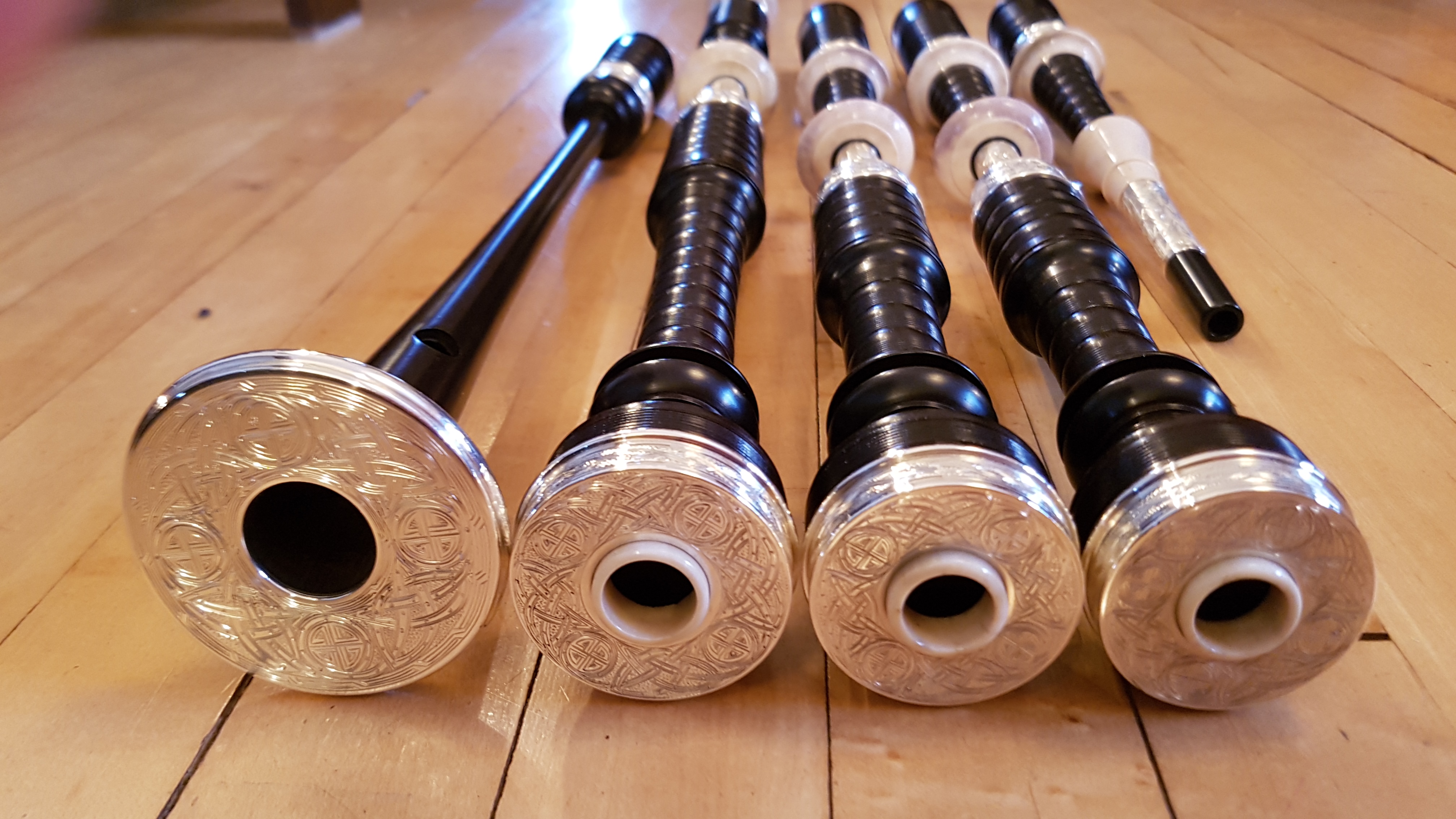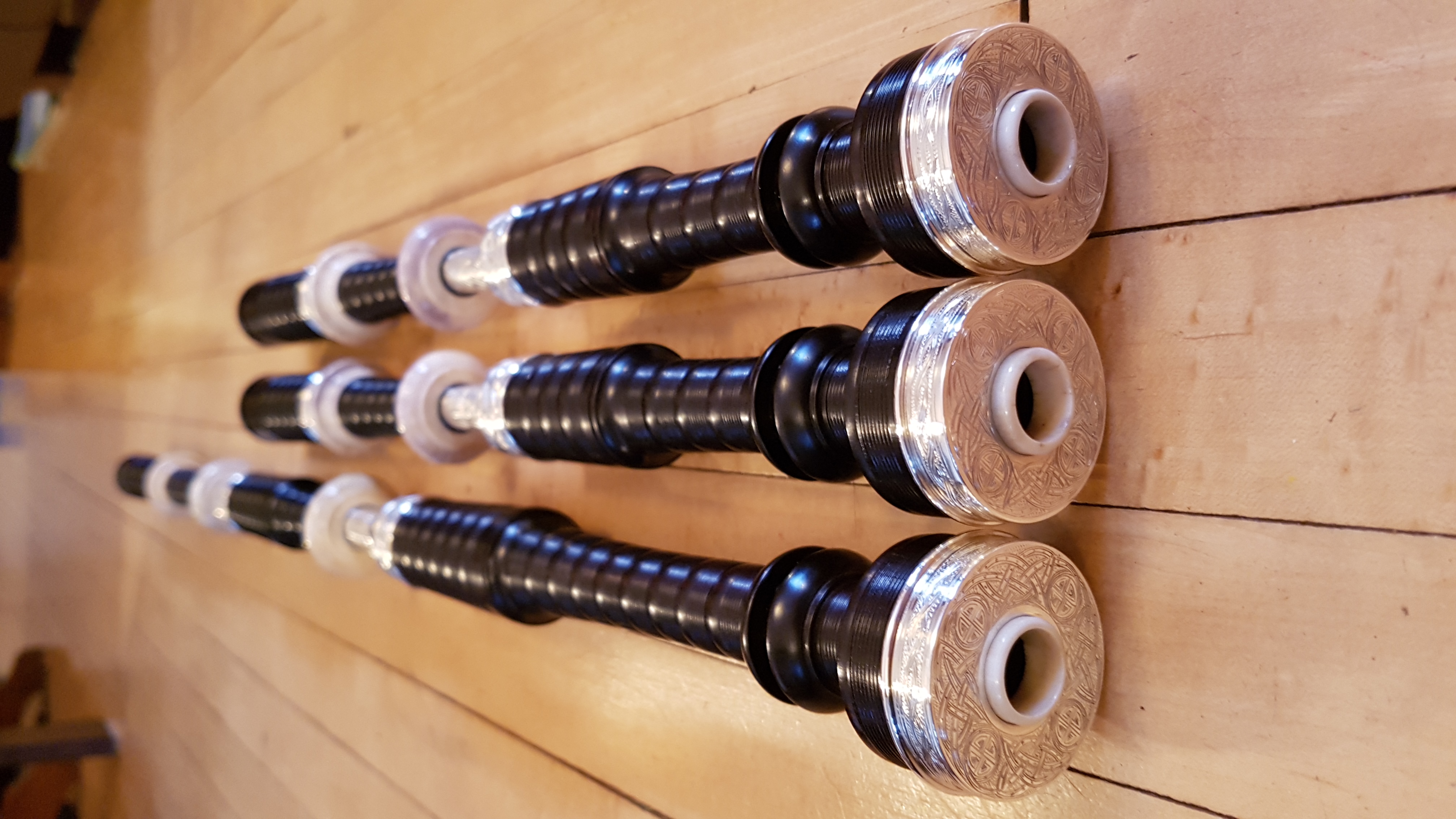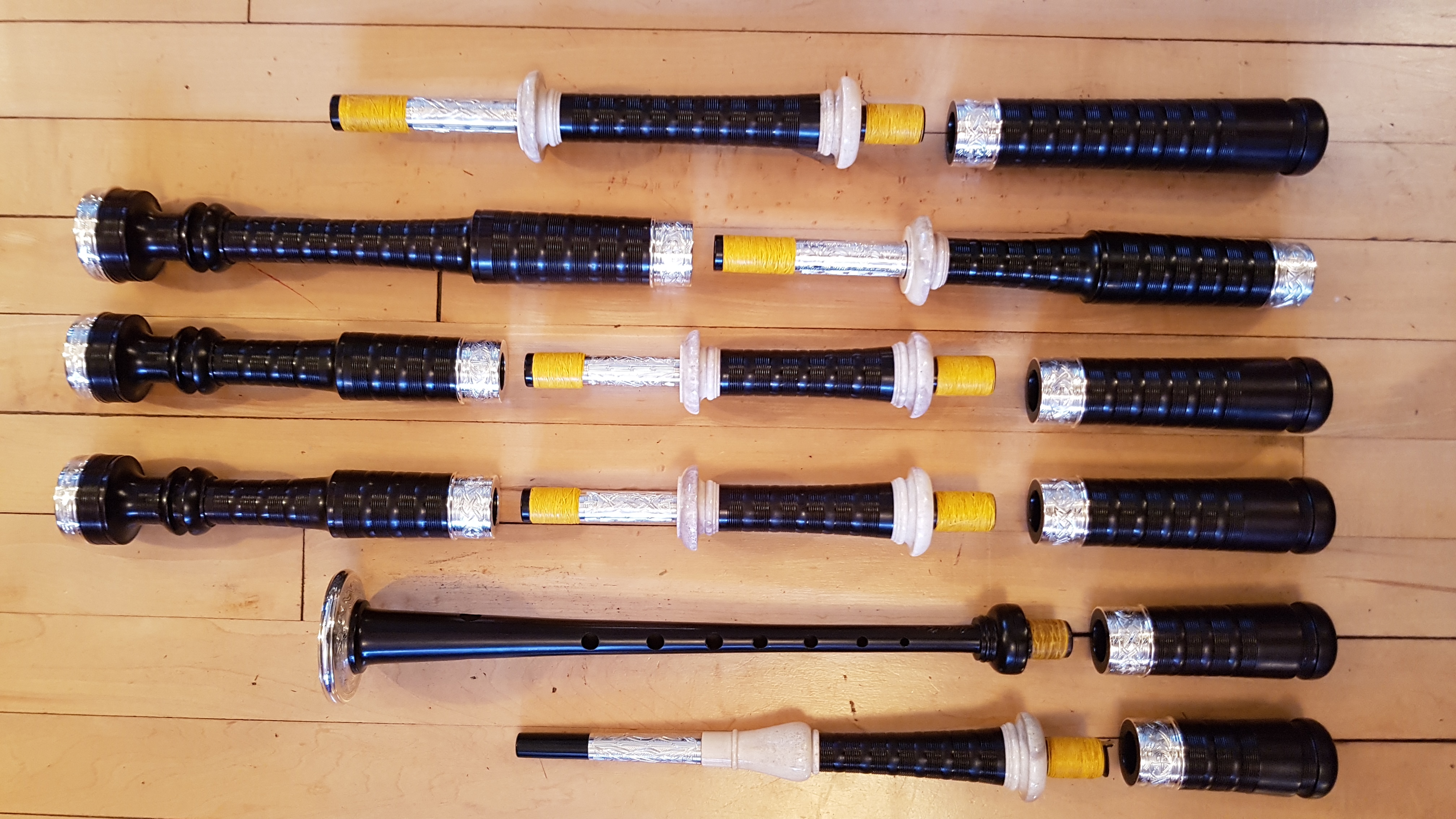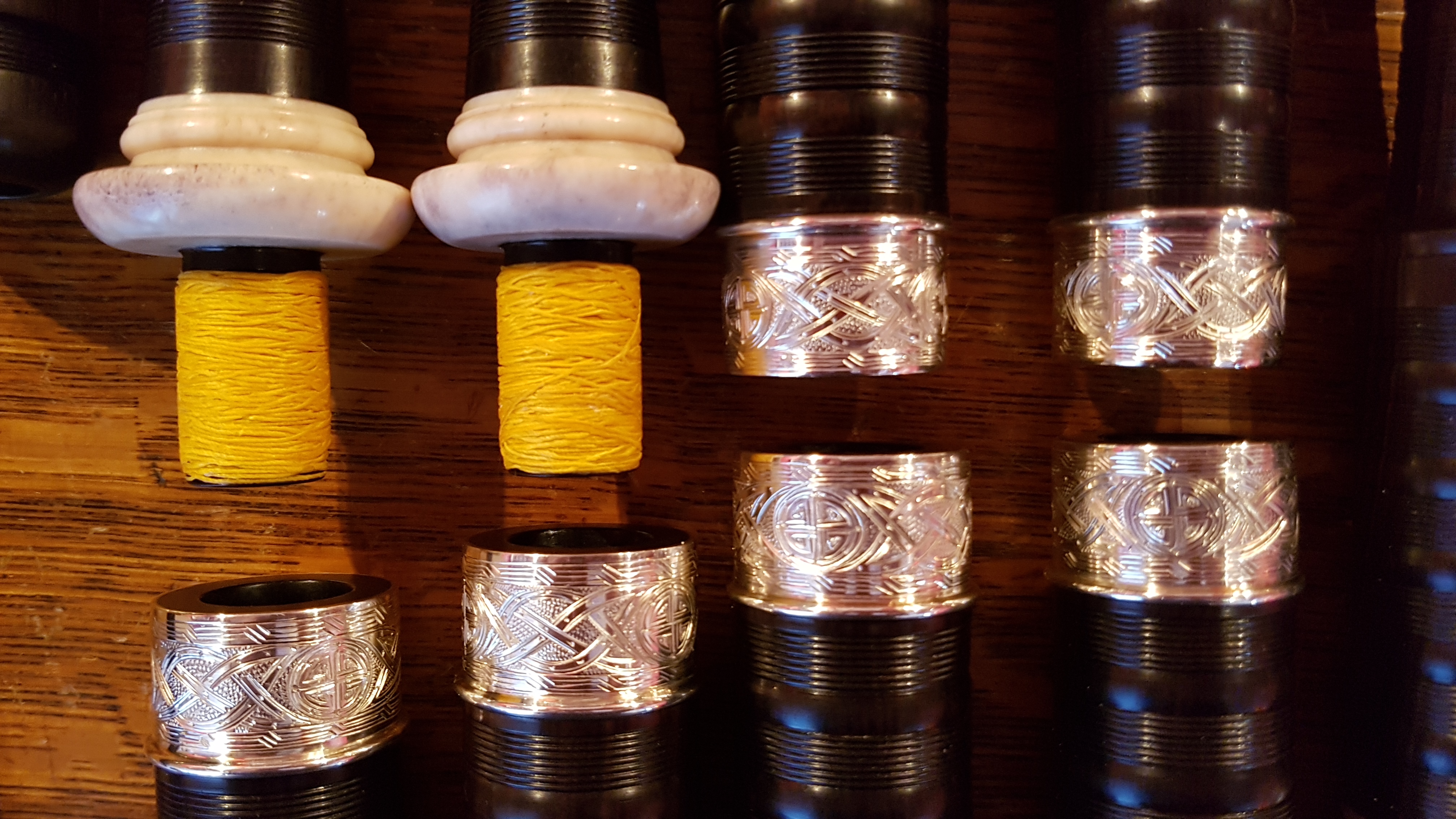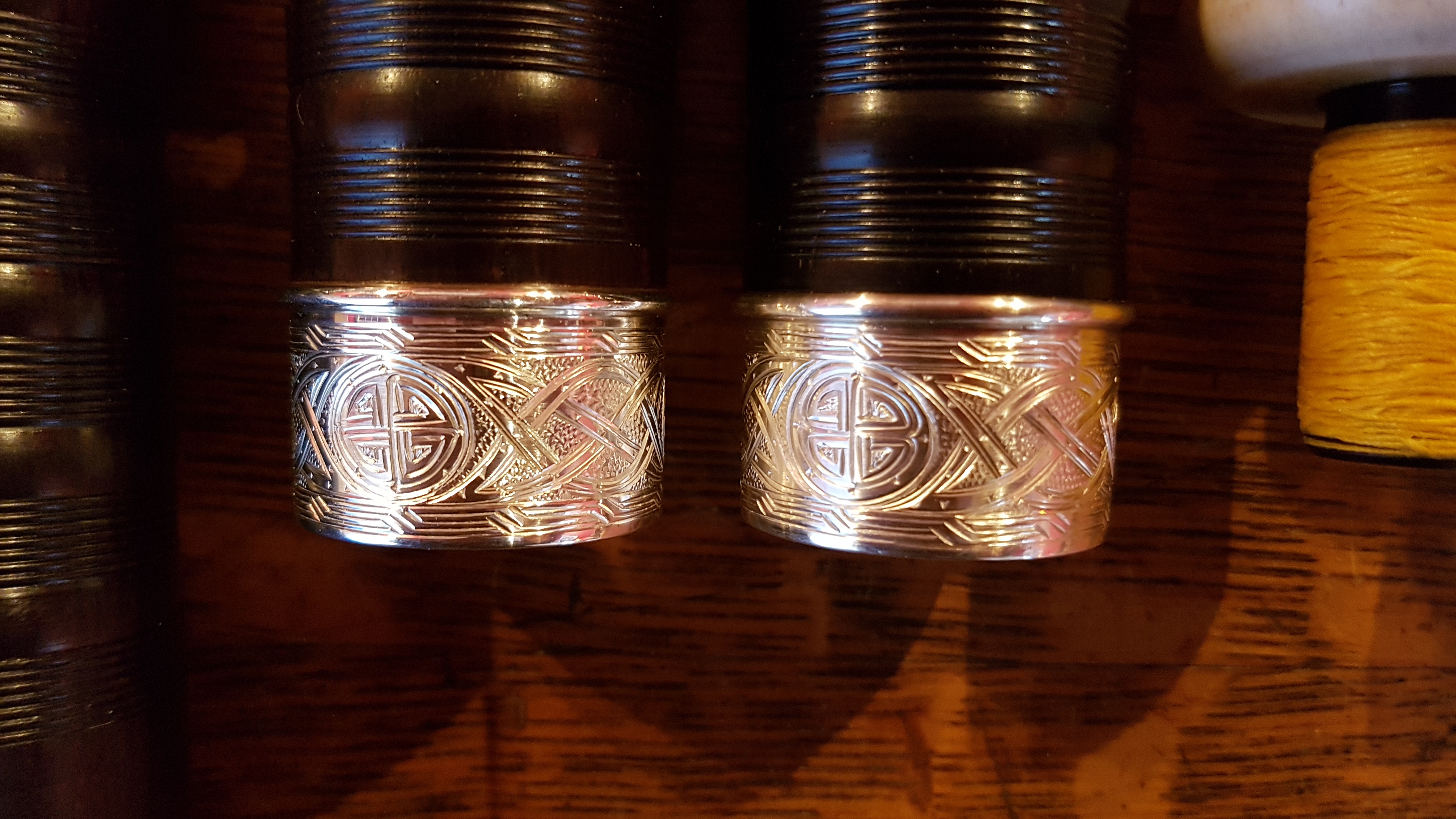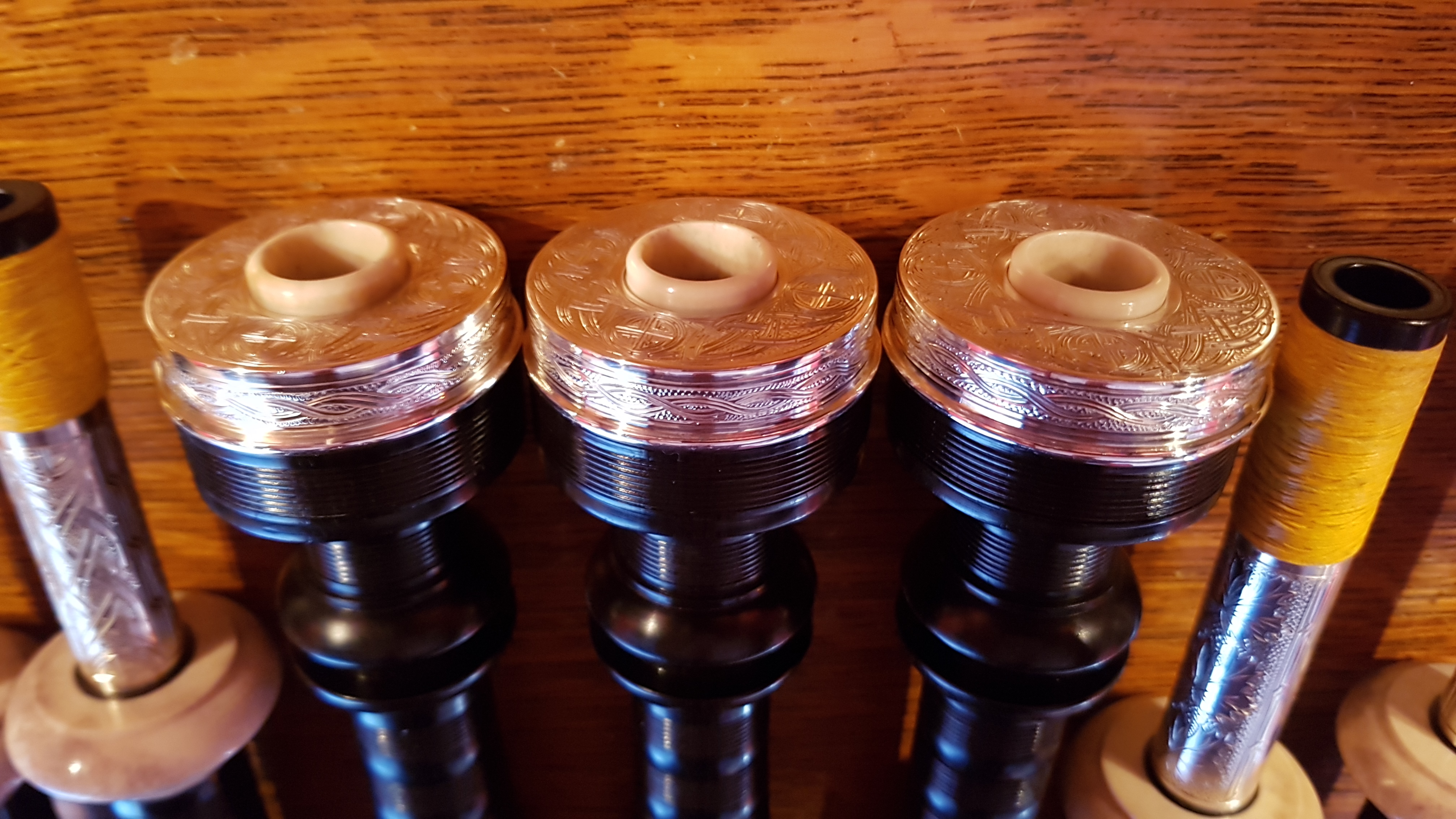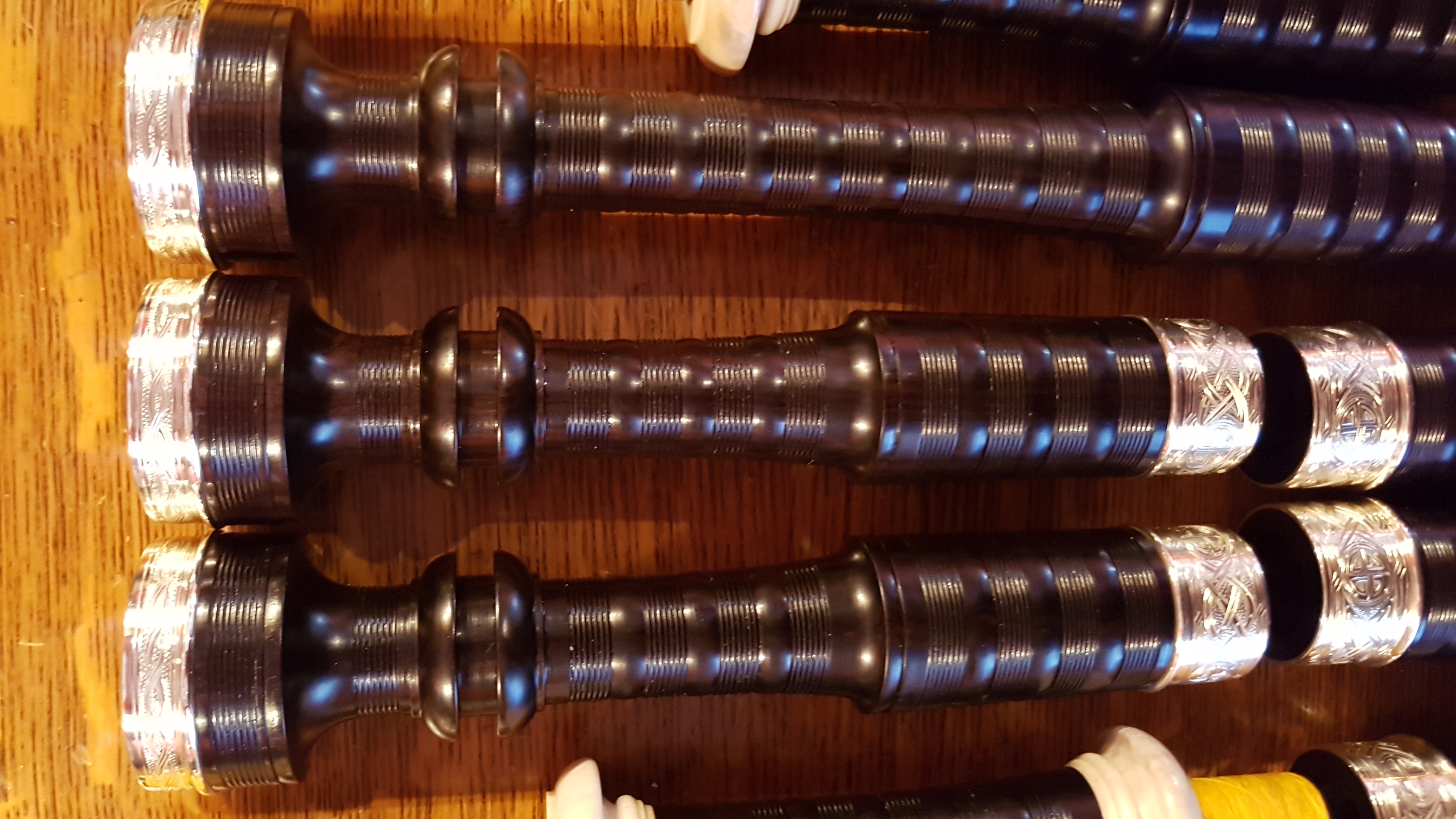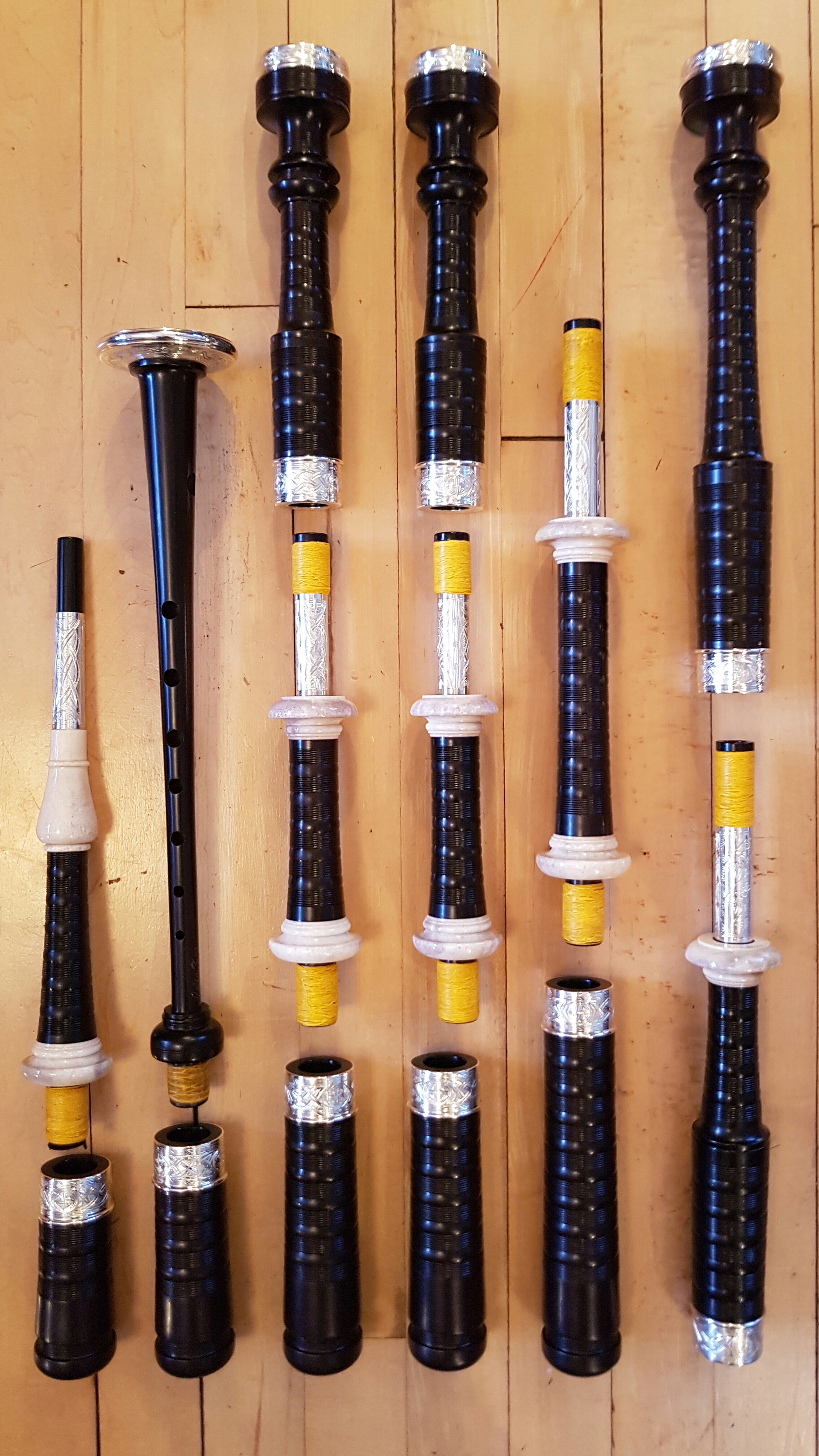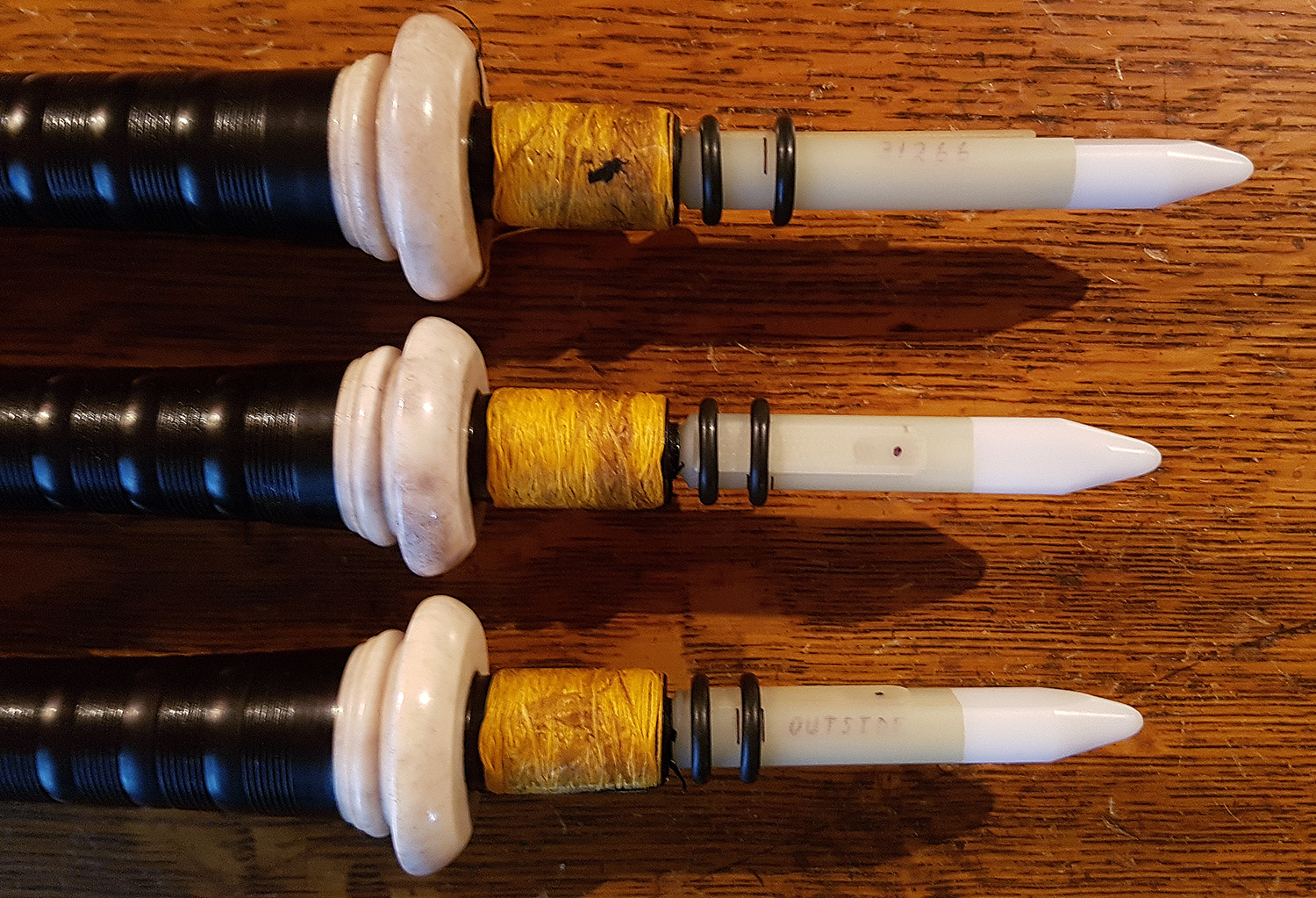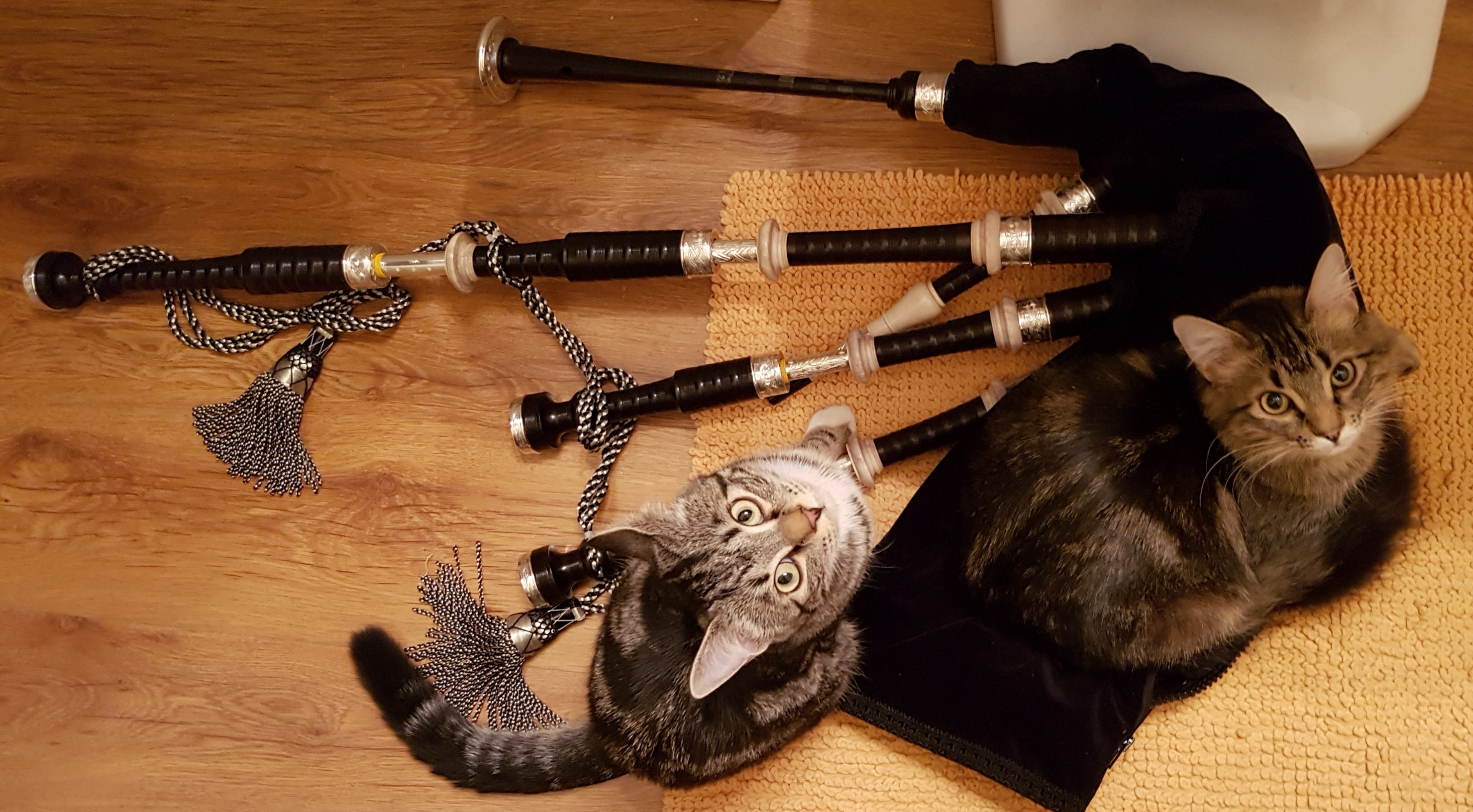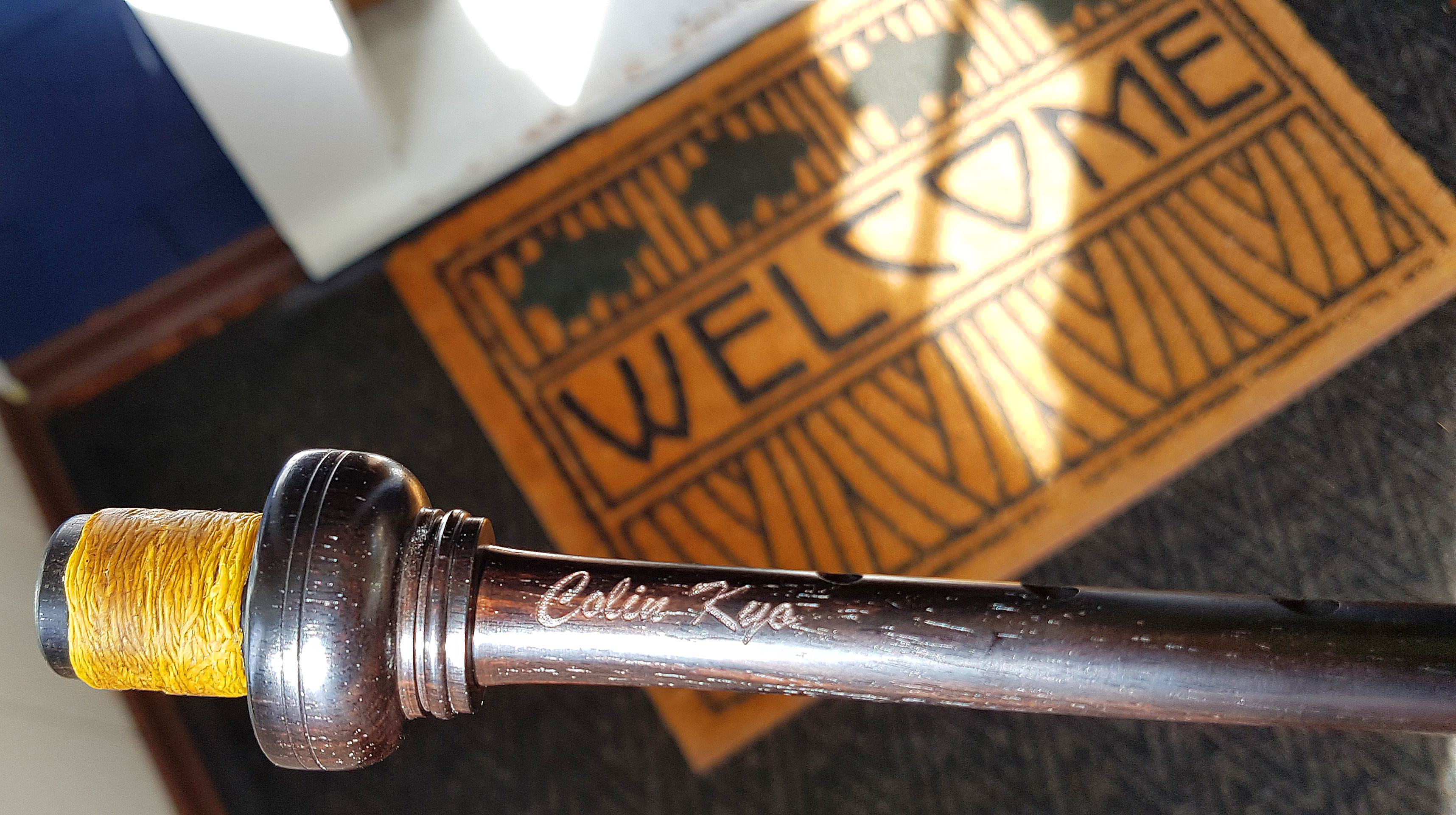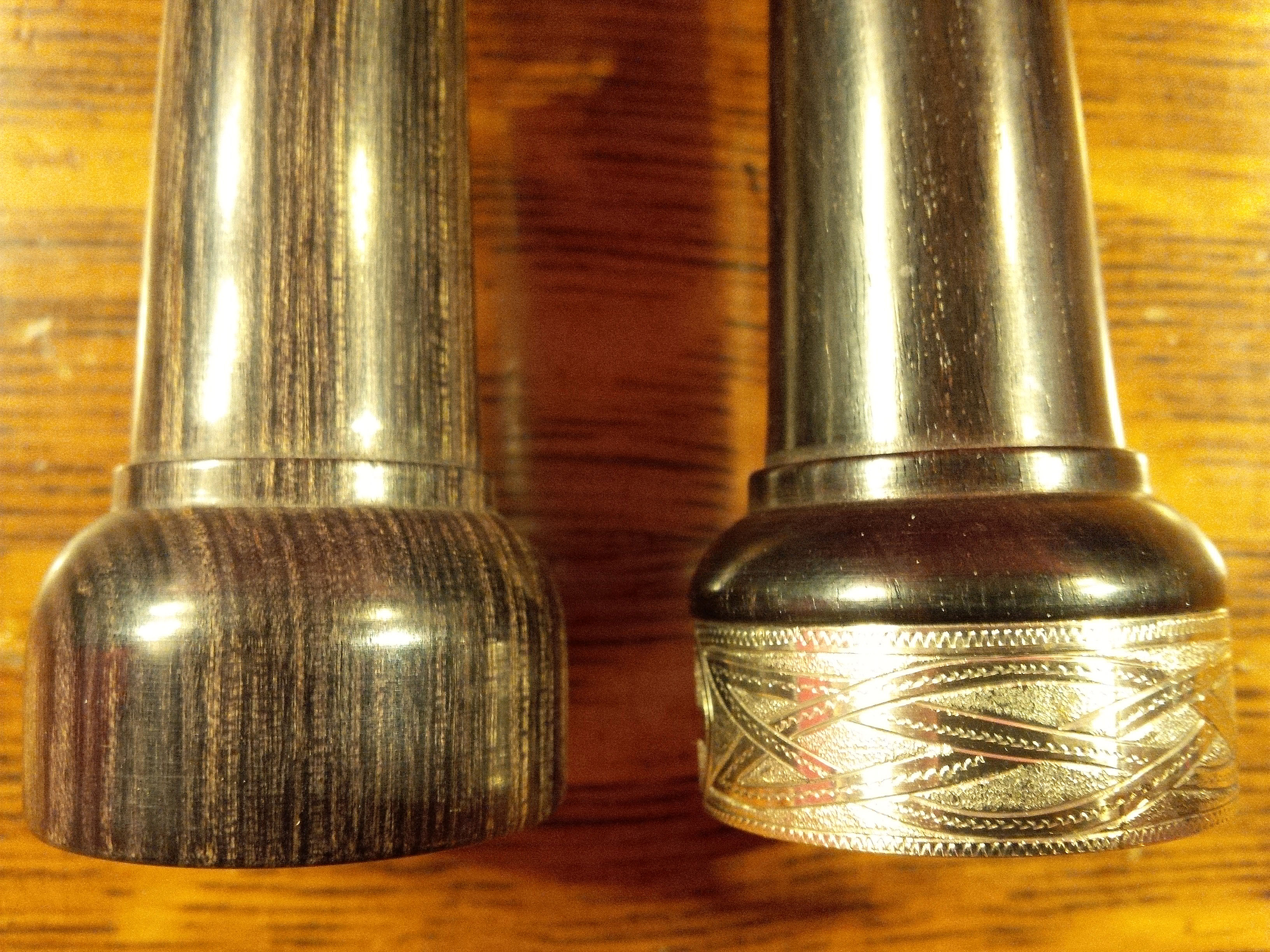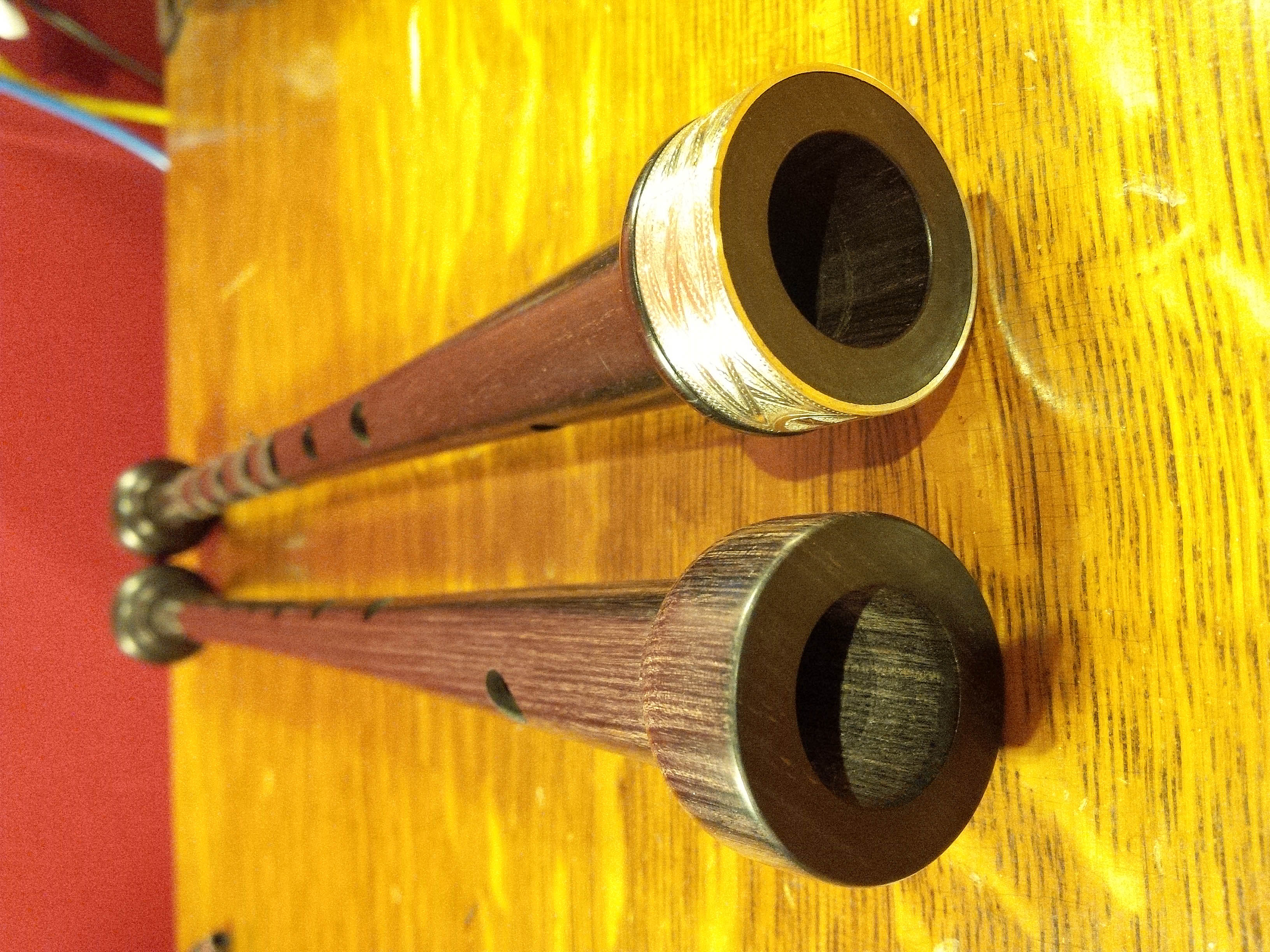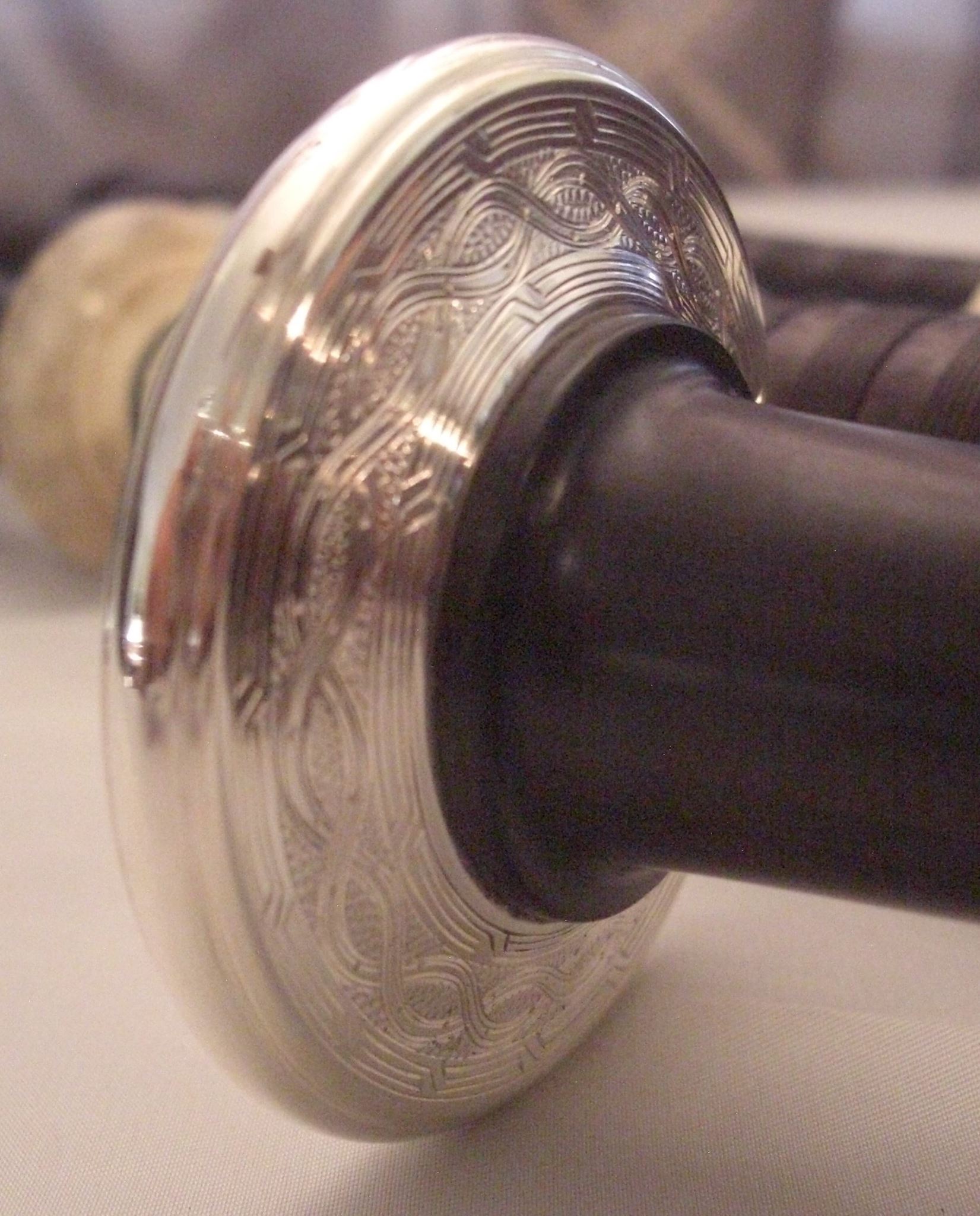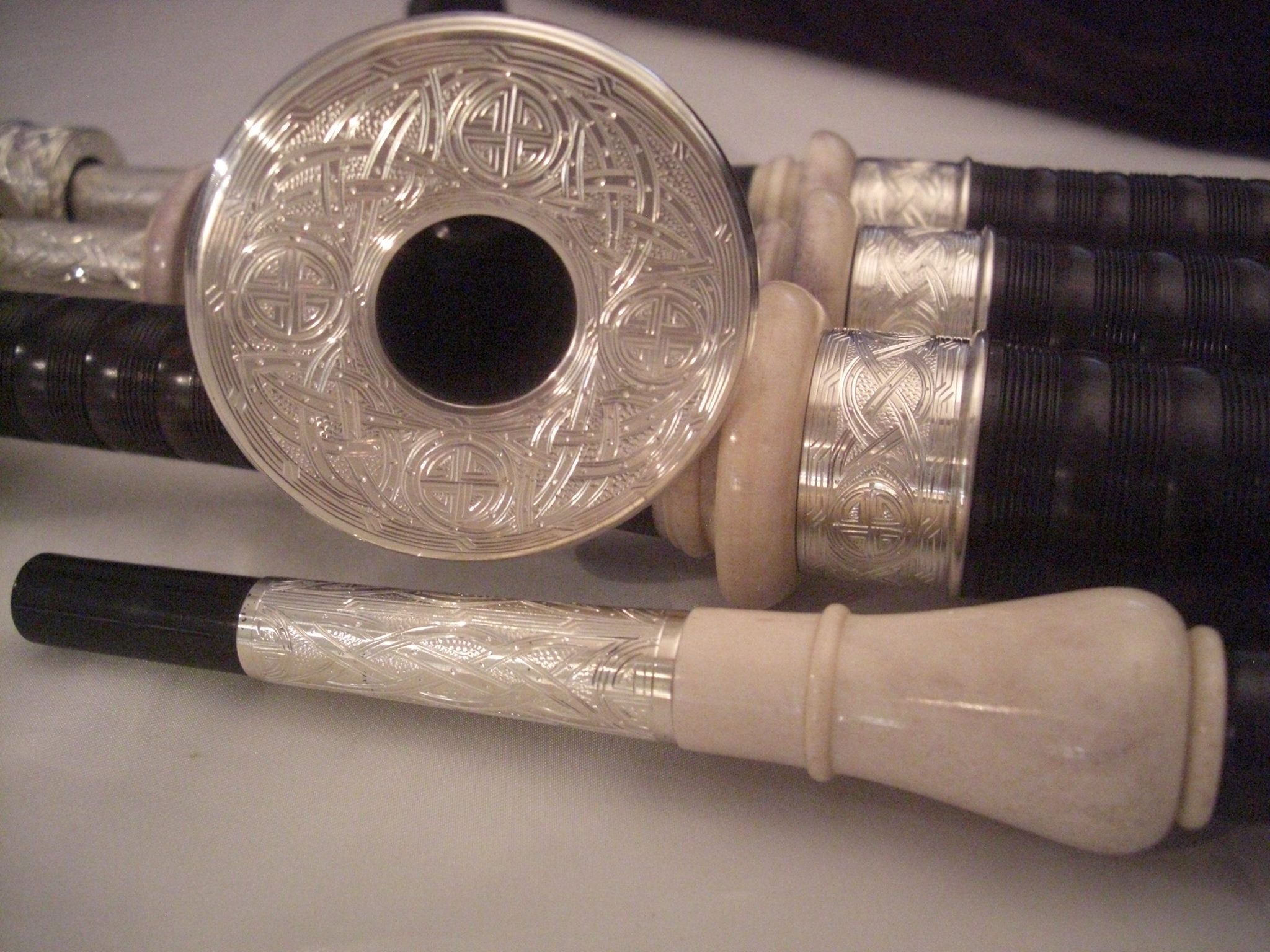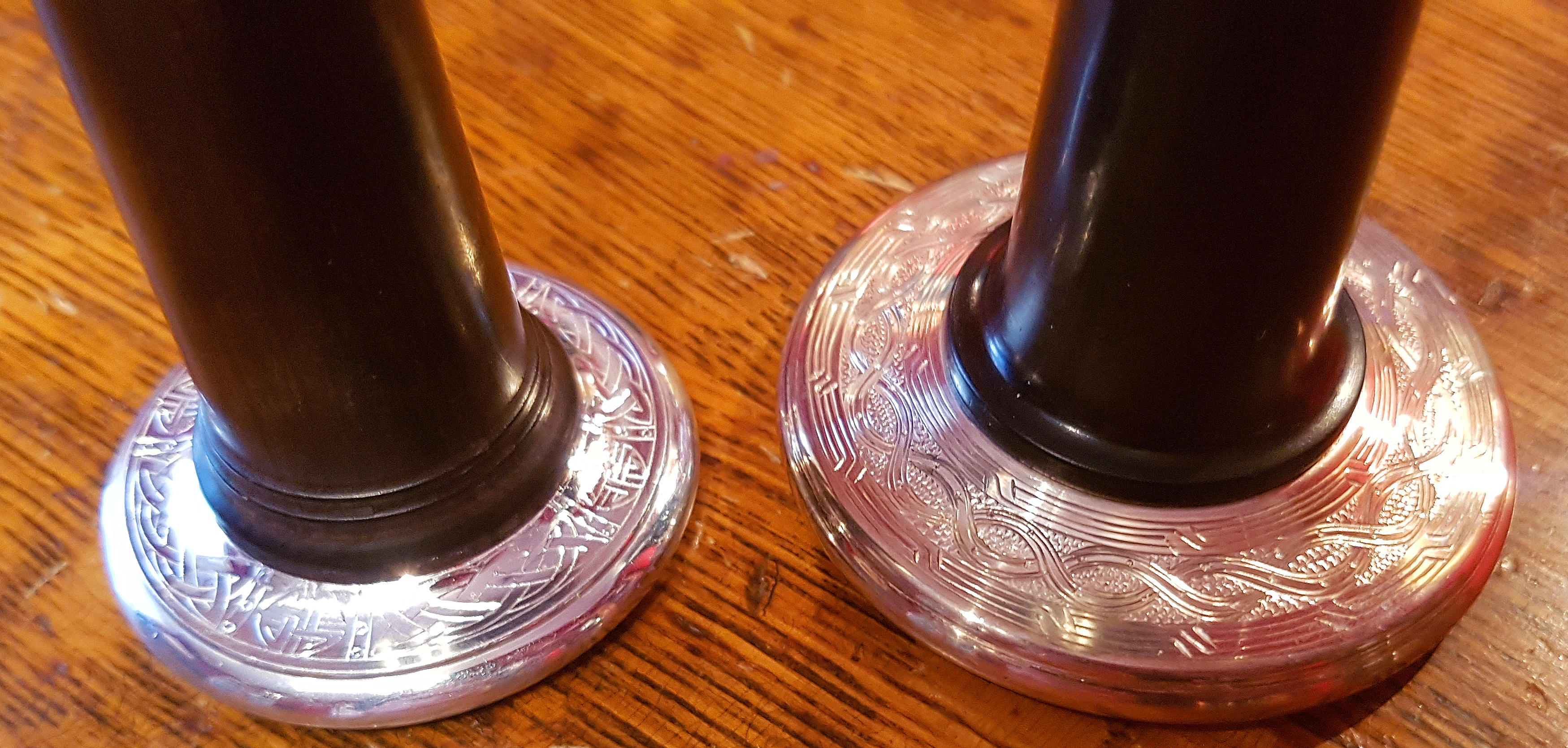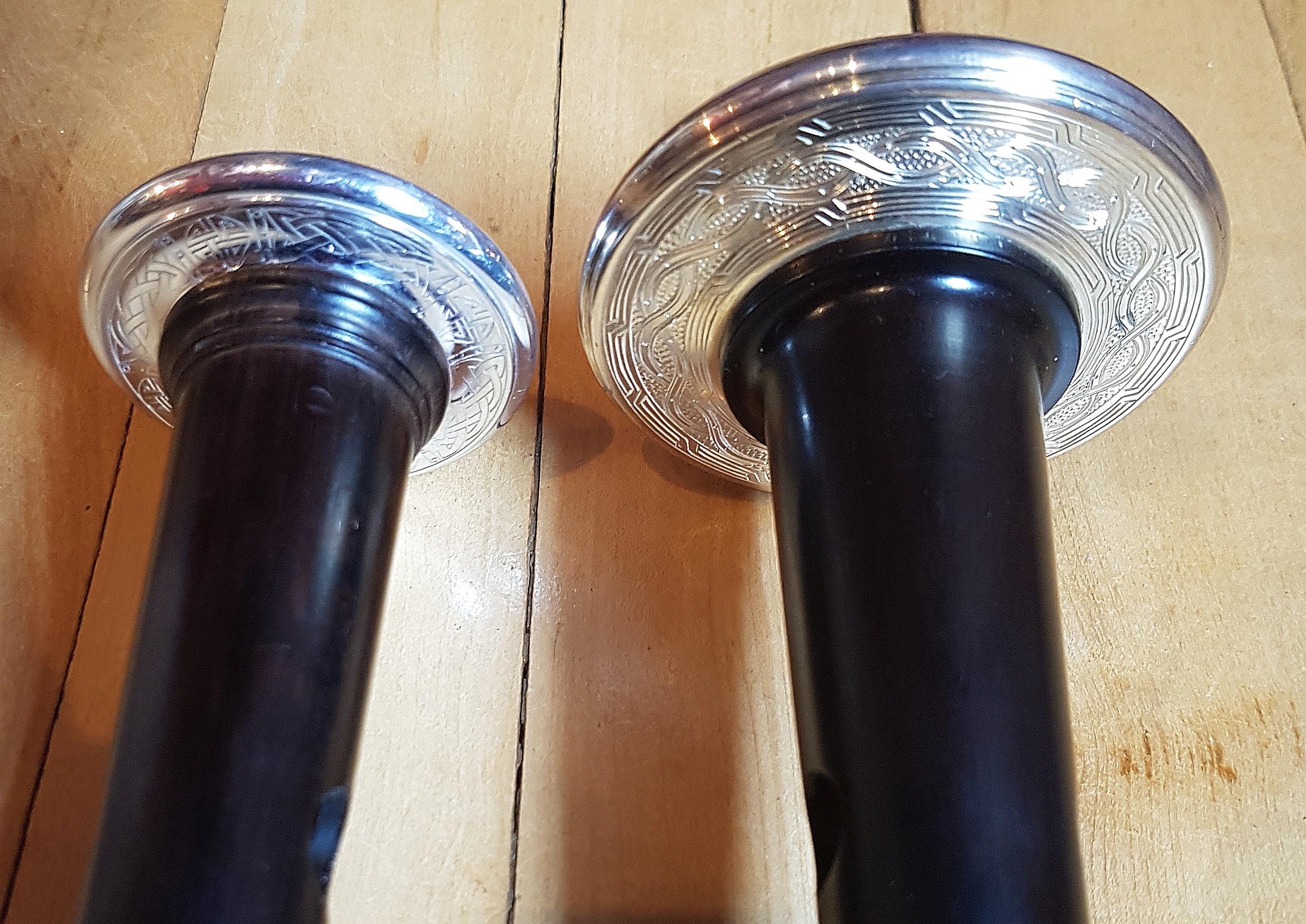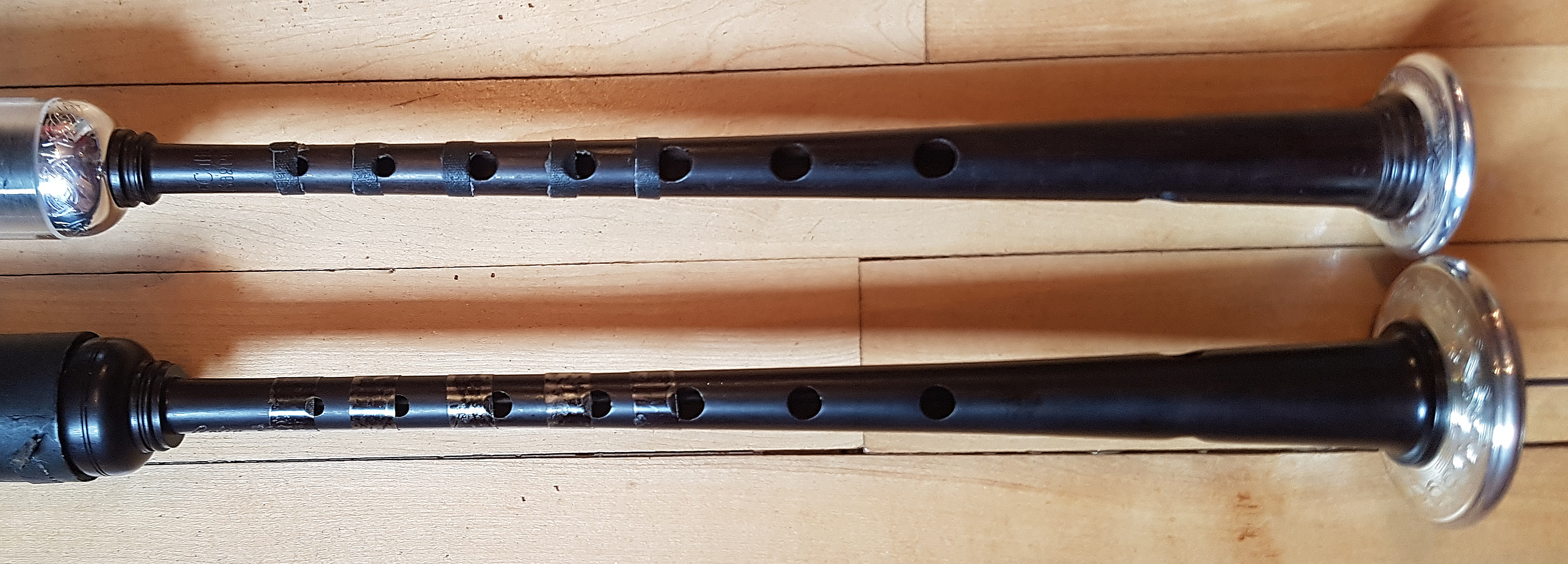Want to learn about one of the most bold and elegant bagpipes out there?
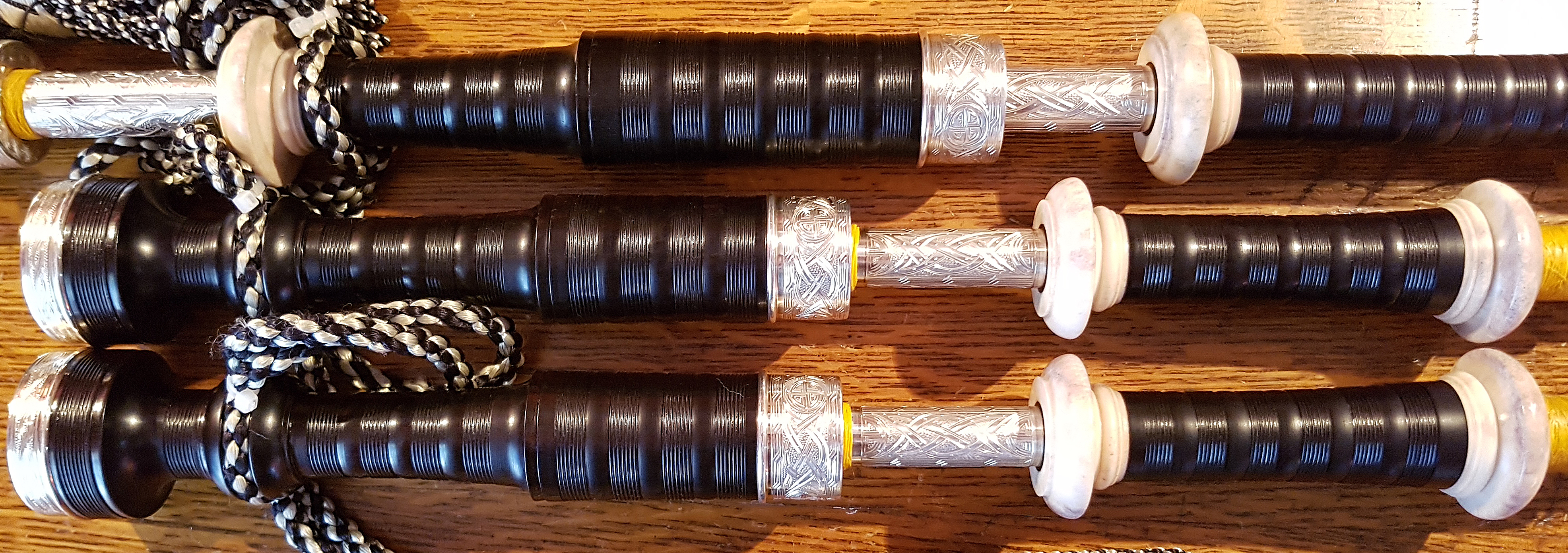
2016 Colin Kyo C-9s with Celtic Commitment Engraving design on sterling silver and moose antler mounts and bushes upgrade.
Over the past couple of years I had been hearing a lot about Colin Kyo bagpipes. These bespoke pipes are handmade by Murray Huggins out of Medford, Oregon. Colin and Kyo are the first and second names of Murray’s and his wife Yoko’s son. This is not an unheard of convention! Ever heard of David Naill Bagpipes? David and Naill are the names of Leslie Cowell’s sons.
Murray has been piping since he was nine years old and cites a number of influences, including Jimmy McColl. He has perfected his bagpipe crafting technique over the last 15 or so years. All the components are designed and handmade by him: the turned African blackwood parts, high-quality mounts, ferrules, slides, and caps made of blackwood, resin, moose antler, and hand-formed and engraved nickel and sterling silver. Murray even makes many of his own tools, like chanter reamers and such; he is a true Renaissance Man! Check out examples of some of his work here. In addition to being an innovative and amazing crafts person, I soon found that Murray Huggins is also a fantastic piper and a genuinely nice guy!
While Murray’s pipes have been lauded as beautiful and well-proportioned, so too has the tone; after all, without good tone, what’s the point? The original design of Colin Kyo bagpipes was based, at least initially, on Murray’s early (~1903) Henderson bagpipes. However, Murray has experimented and tweaked the bores and other parts (e.g., the stocks are tapered) to develop a truly unique drone sound. Colin Kyo pipes are known to be very robust in tone, with lovely tenor harmonics and a quite well-integrated but full and deep bass. Brett Tidswell has a great review here, Patrick McLaurin has loads of reviews and sound files here, and numerous glowing reviews can be found on the Dunsire Bagpipe forum here and testimonials on the Colin Kyo website here. Make sure you search Patricks’ and the Dunsire’s sites for further information, where there’s been quite a bit of testing, feedback, and discussion. The sound files and videos of Patrick McLauren playing Kyo pipes on his blog and Youtube and these videos of Matt Pantaleoni playing his 2016 Colin Kyos with a cane bass and Ezeedrone tenors here, and here, will give you and idea what to expect in tone.
Murray’s production is modest — he is a one-man shop — but enough Colin Kyo pipes are out there now that people are taking notice, with a few very accomplished pipers competing and winning with these pipes. Erik Leiken recently won overall at the 2017 Angus MacDonald Championship in San Diego, California with his moose-mounted blackwood Kyo pipes and poly Kyo chanter. Matt Pantaleoni has been competing with Kyos — here is a video from the 2016 MWPBA Solos competition with his engraved Colin Kyos (but I believe with a Naill chanter):
Here are a few images of Matt’s CK-9 pipes that I pulled and tweaked from the Colin Kyo Facebook page:
Here are some Kyos at Gord MacDonald’s Island Bagpipe — I’m pretty sure they’ve both been sold…
And finally, here are Murray’s own pipes for good measure: button mounts and engraved nickel — simple but very elegant, and likely very light on the shoulder, those Kyo pipes are not heavy.
So, it’s settled. Colin Kyo bagpipes look and sound great. Now to look for a set to try out, or buy…
Working With Murray at Colin Kyo Bagpipes
I began my search thinking used. All of the sets of bagpipes I have purchased to date were used (which is why I can afford four!). But finding a used set of Kyo bagpipes is easier said than done; no one seems to want to part with their pipes and those who might were asking almost what they paid for their pipes new! It then dawned on me that I could order new, perhaps something in exactly the pattern that I wanted. To make way, my Gibson 110As were soon sold (now being played in Alaska) and after a brief email to Murray, who very quickly responded, the discussion began in earnest…
Murray has lot’s of energy and is full of ideas. I knew that I wanted moose antler on the pipes in some form, but also an engraved pattern in nickel, maybe even something customized, with a Canadian theme. Murray’s nickel and silver engraving is quite sought after, with orders for mounts, ferrules, slides, and caps being sent all over the world. The wait time for these pipes was to be a month or two, so I had time to decide (as of June 2017, the wait is now almost a year). My own ideas and Murray’s new ideas notwithstanding, Murray’s Celtic Commitment Pattern was beginning to speak to me. Then, out of the blue, a used set of recently made (Fall 2016), moose antler-mounted Celtic Commitment engraved pipes, complete with the venerable Colin Kyo chanter with engraved sole, came back into Murray’s possession — and he offered them to me. The only trouble — if you want to call it that — was that the set was in silver ($$$) and that I already have two Kyo chanters!
But first the silver. I never thought I’d have a set of silver pipes, particularly because I am a relatively new piper (aren’t silver pipes only for top competitors?) and also because of the cost. However, the pipes, while in immaculate condition, were used (making them very affordable), there is a wait for new Colin Kyo pipes (who wants to wait?), and I could always sell one of my Kyo chanters ($) and some other surplus stuff — I only needed one evening to think about it — these pipes would be my lifetime set. And they are used — I’m five for five used sets!
One last detail. These pipes had been customized by the original owner and Murray offered to change out the engraved top bass slide. Free of charge. Murray has class and strives to please his customers. For the slide we settled on a pattern incorporating 1/3 Celtic Commitment, 1/3 Colin Kyo 2016, and, wait for it, 1/3 hard maple leaves – Oh, Canada. Murray engraved the new slide, completely reconditioned the pipes, turned a proper length blowpipe, and shipped them off to me in the mail — just before the new African blackwood duty came into effect in January 2016. These add-ons, free of charge. Did I mention that Murray has class and strives to please his customers?
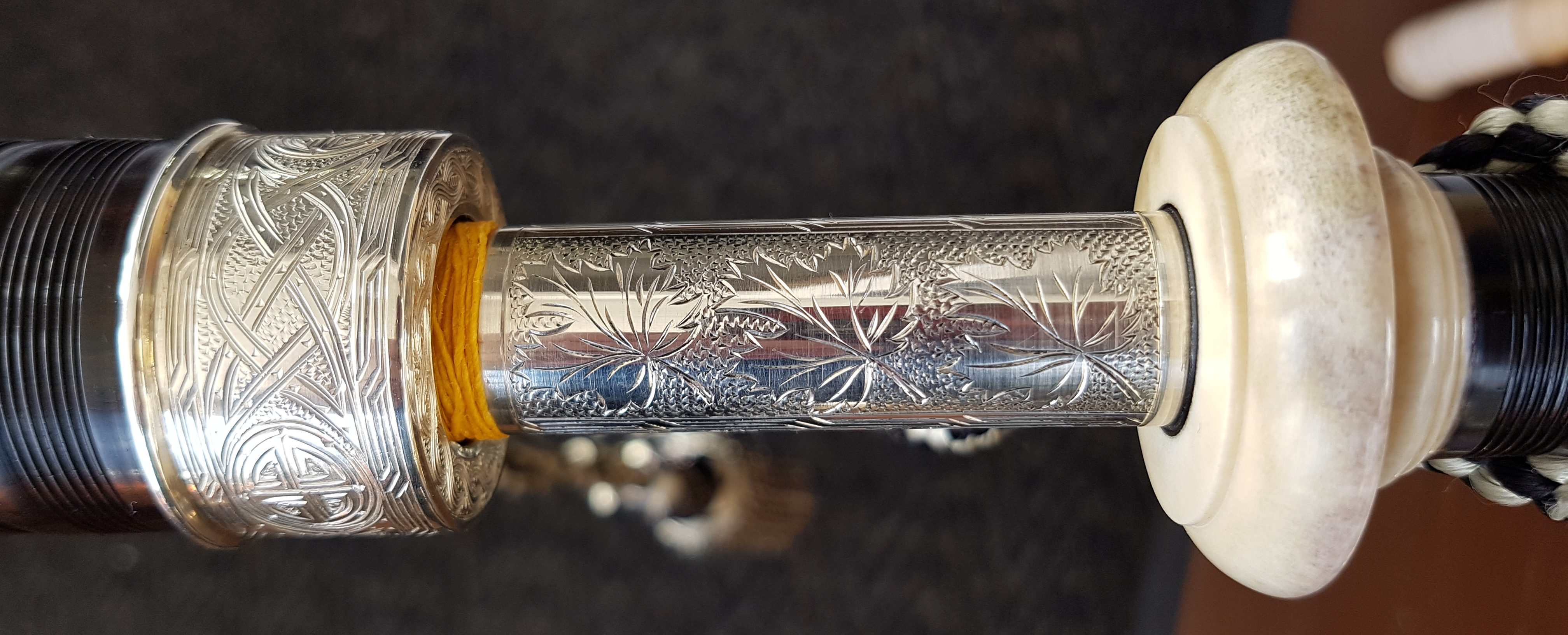
Customized slide with three maple leaves on 1/3 of the surface — go Canada! — on 2016 Colin Kyo C-9s with Celtic Commitment Engraving design, and moose antler mounts upgrade. The other 2/3 of the slide are comprised of “Colin Kyo Bagpipes 2016”, and Murray’s Celtic Commitment pattern.
Unboxing Colin Kyo Bagpipes…
The pipes arrived as well-packed as the pipes are well-made. Here’s the unboxing, a pot of coffee brewed and the fireplace on… The twin kittens enjoyed it as much as I did…

And now for the freshened and unhemped pipes! Yowzers, look at that workmanship!
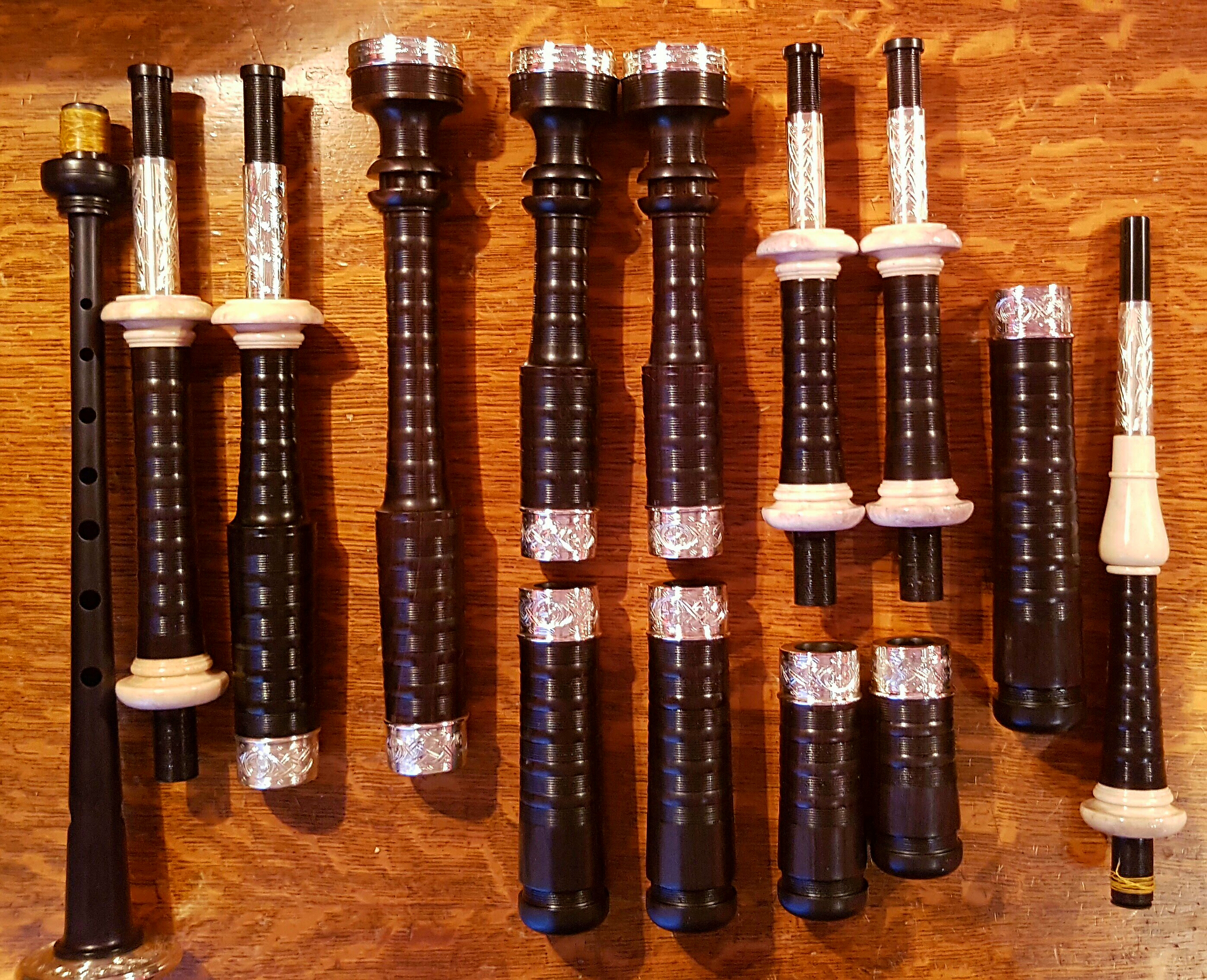
Refurbished and customized 2016 Colin Kyo C-9s with Celtic Commitment Engraving design, and moose antler upgrade.
The design of Colin Kyo bagpipes has evolved since Murray began turning pipes in his garage in the early 2000s. Here’s a neat article about Murray in 2003. Today’s Colin Kyo bagpipe design is quite refined and elegant in whatever combination of materials, mounts, slides, ferrules, and caps the pipes come in. Just review some of his work here. In hand the pipes are surprisingly delicate-looking, with the moose mounts comparatively smaller than the mounts on other makes. The beading and combing, while distinct, is quite refined compared to that of other makers; Murray recently remade his beading and combing tools, so today’s sets have a finer look than his older sets. That said, these pipes are solid.
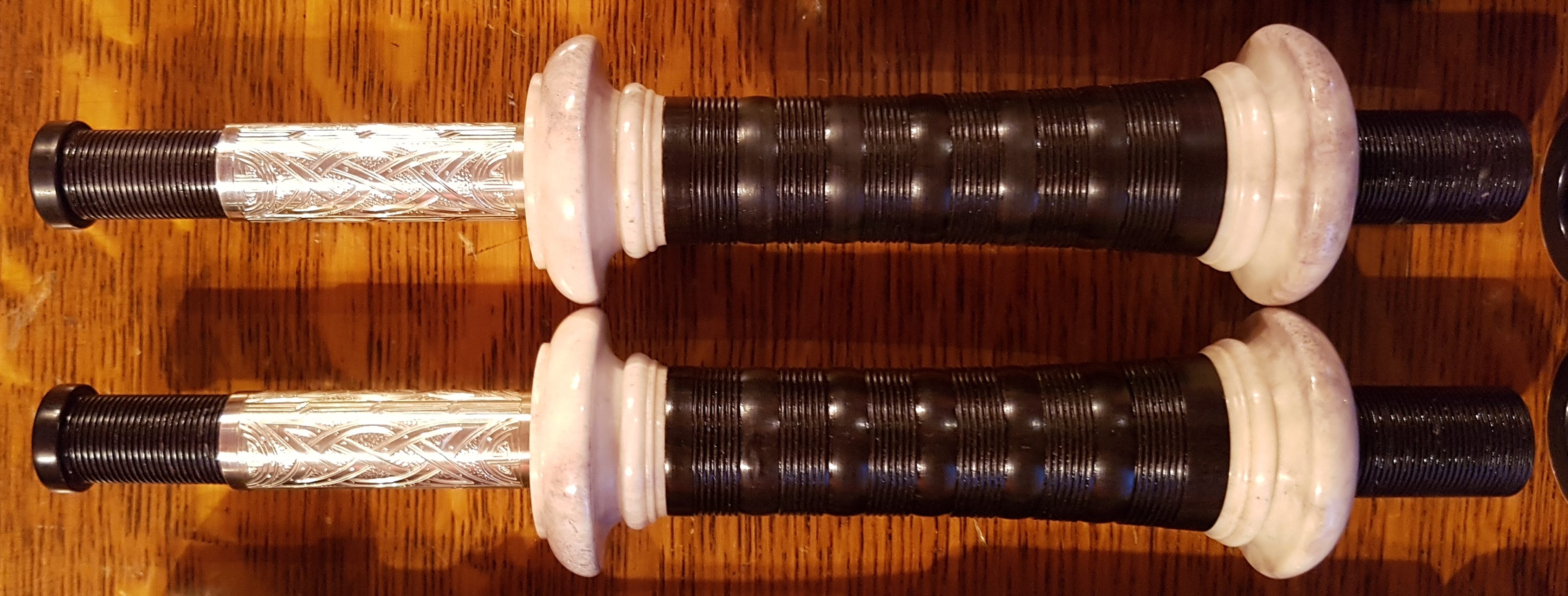
I just love the moose antler mounts. They are an interesting blend of creme, gray, and even hints of purple — just lovely to look at and touch, smooth as glass and, while light, they appear to be very solid and dense.
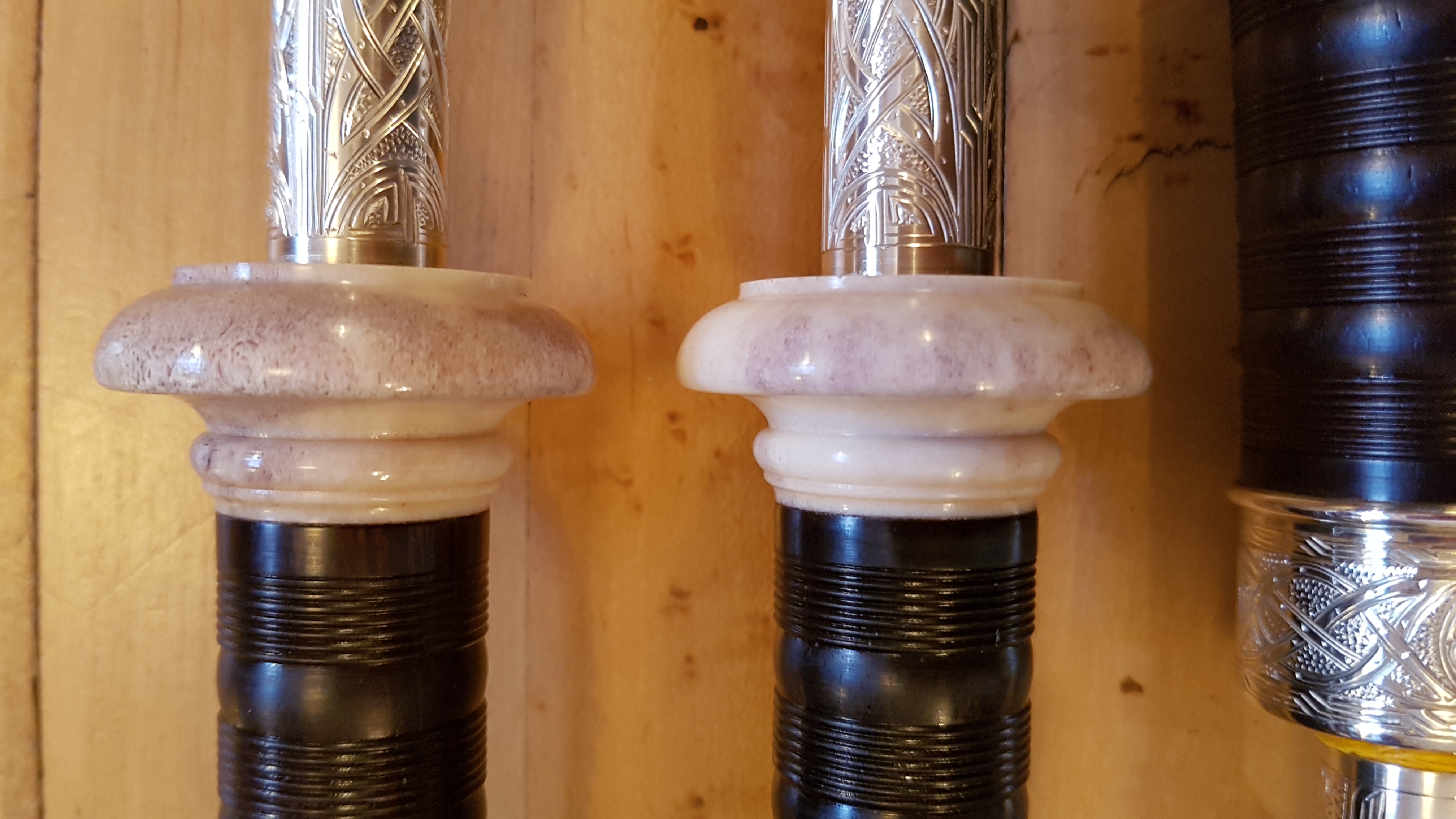
The top moose antler projecting mounts on the lower tenor joints. This particular moose antler is from Montana, not far from Yellowstone National Park.
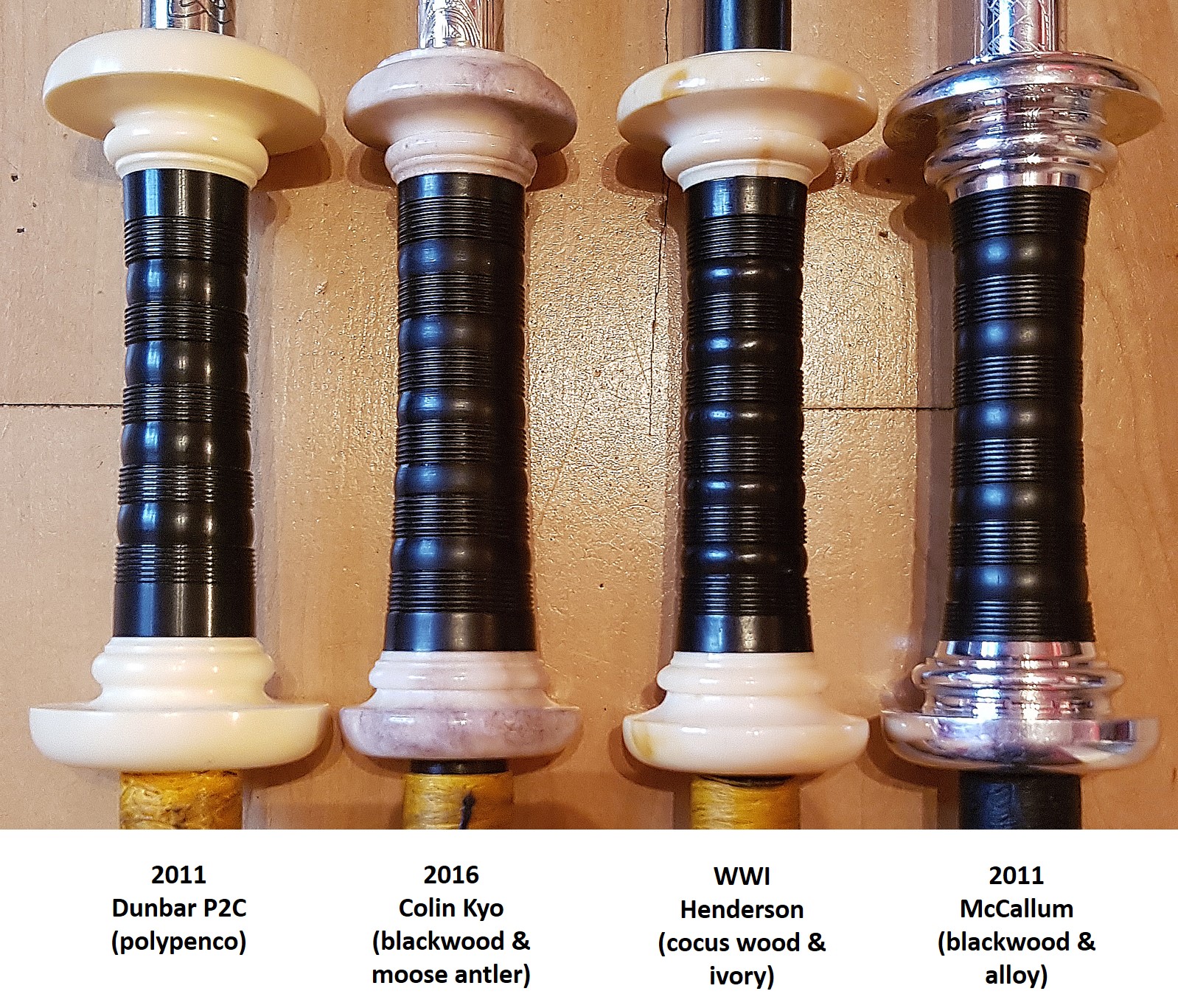
Heres’s a comparison of mounts on tenor joints on four sets of pipes spanning approximately 100 years. One can see that the latest version of Colin Kyo mounts are delicate looking compared to other sets of pipes, including earlier Kyos.
Here’s what Moose antler blanks look like before turning. The usable material can only be taken from antler near the base beneath the tines called the beam. As of June 2017, Murray’s supply of aged moose antler has been exhausted and he is focussing on silver and nickel and blackwood mounts. Hopefully, a new supply will be soon acquired as Murray does a fine job with this material. Murray mentioned that the antler needs to aged for approximately a year before he will turn it into a finished part.
The overall profile of today’s Colin Kyo pipes is rooted in a traditional design, making these pipes quite timeless. However, there are some specific features that readily identify Kyo pipes and add, if I might, a sexy element. One of these, it could be my favourite element, is the sweeping and smooth fountains of the drone tops. Naked…, there is no combing or engraved lines here and the effect is one of strength and sultriness. Another is the unique cord guides which share elements of the Glasgow and Edinburgh schools of bagpipe-making. I think that these guides are one-of-a-kind, with just the right balance of male and female, old and new, if you will. The other components all have subtle but unique profiles which harken back to another time, but are also modern; as noted Murray’s design has evolved remarkably since he first started turning pipes and the current profile is very elegant and balanced.
Colin Kyo pipes are finished in Murray’s and Yoko’s new and durable spirit-based varnish. The wood has a nice, warm glow without being too shiny and the external surface accepts bore oil and wax without issue.
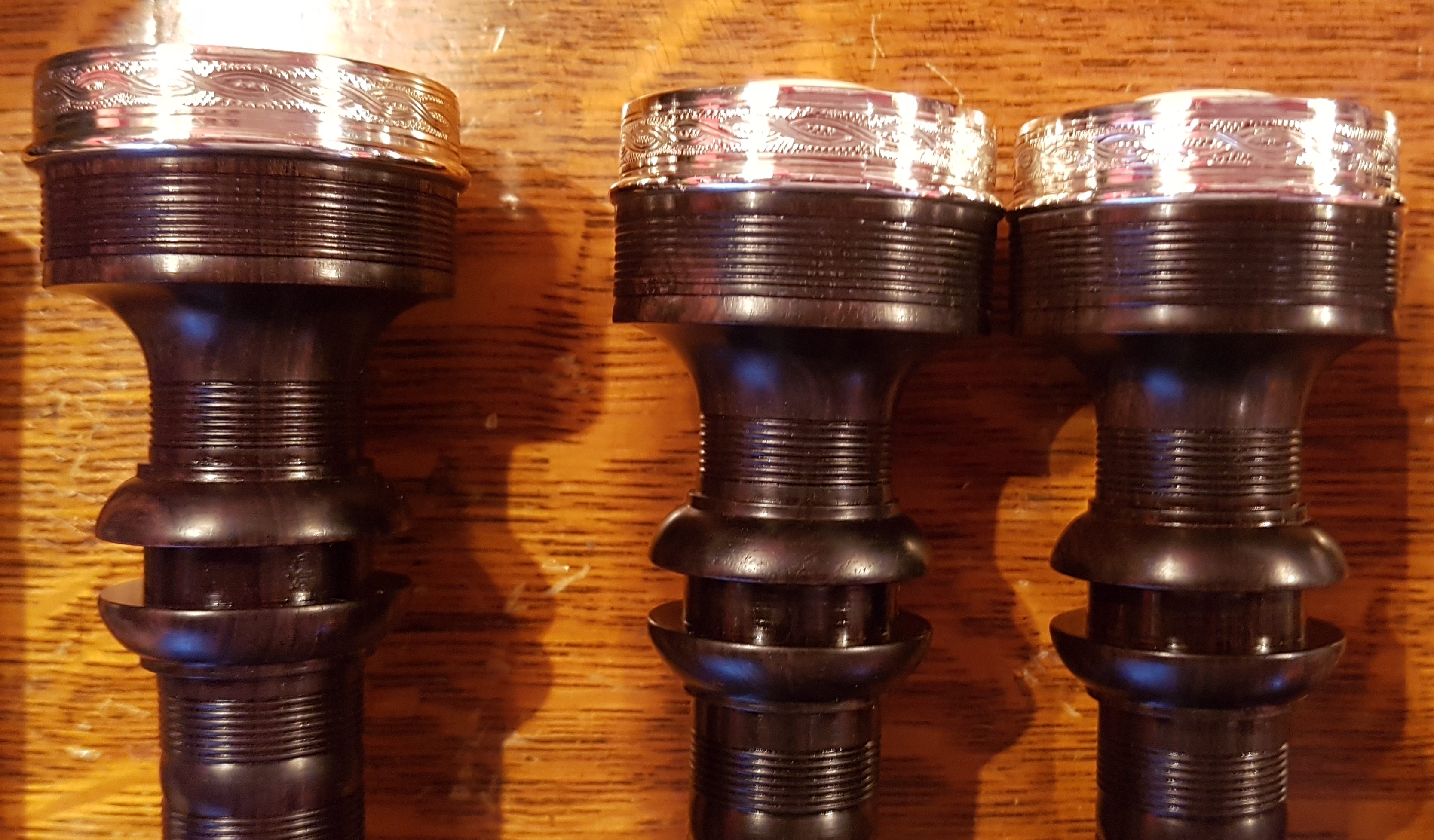
Check out Murray’s unique cord guides which share elements of the Glasgow and Edinburgh schools of bagpipe-making. They are one-of-a-kind, and have a nice balance between male and female, old and new. It’s almost a shame to have to put cords around them!
Overall, the pipes are very well-balanced in hand and on the shoulder, particularly for having so much silver. All of the pieces, including the chanter, without pipe bag weigh only a little over 4.5 lbs. Tied into a Bannatyne hybrid, and with a bag cover, cords, and reeds, my Kyos pipes weigh about 6.5 lbs (without MCS). For comparison, in a similar configuration, my African blackwood and alloy McCallums weigh 6.7 lbs, my poly and nickel Dunbars weigh 6.5 lbs, and my cocus wood and ivory Hendersons weight about 5.6 lbs.
It should be noted that the Kyo pipes would be marginally lighter without the 2.5 inch diameter engraved silver soled blackwood chanter; This chanter weighs 5.6 ounces vs. 3.4 ounces for a poly McCallum C3 chanter.
Engraved Silver
I love engraved bagpipes and have two other sets of pipes with engraving: Dunbar P2C celtic-engraved 3/4 nickel and McCallum celtic-engraved full alloy. However, both of those sets of pipes are machine-engraved — nothing wrong with that, they look great (!) — but these Colin Kyo pipes are clearly the most ornate with their hand-tooled Celtic Commitment engraved 3/4 sterling silver — look at that shine and pattern!
As noted, I never thought I’d go for engraved silver but when this opportunity presented itself, I am glad that I accepted it. Murray’s engraving is absolutely top notch and it is all done by hand with simple tools. While all of Murray’s in-house designs, and those personally customized for customers, are beautiful, in my opinion Murray’s Celtic Commitment design is one of the best designs I’ve ever come across. I can look at the design over and over and still find interesting little flourishes I never noticed before. Quite simply, it is a feast for the eyes and is my favourite pattern. Not a bit of space is wasted; if you’re going for engraved parts you want the surfaces to be fully engraved! As an aside, Murray’s Celtic Commitment design is somewhat reminiscent of a design I’ve seen on 1903 MacDougall’s. I prefer Murray’s pattern which is more balanced and doesn’t leave you ‘anxious’ after looking at it — full of detail but cleaner is probably a better descriptor.
Re silver vs. nickel, I had one of Murray’s engraved nickel sole chanters for a comparison to my silver chanter. While the engraving effect is the same, Murray’s silver has a much warmer tone. This is not necessarily better, just different. When you go for silver you go for warm…
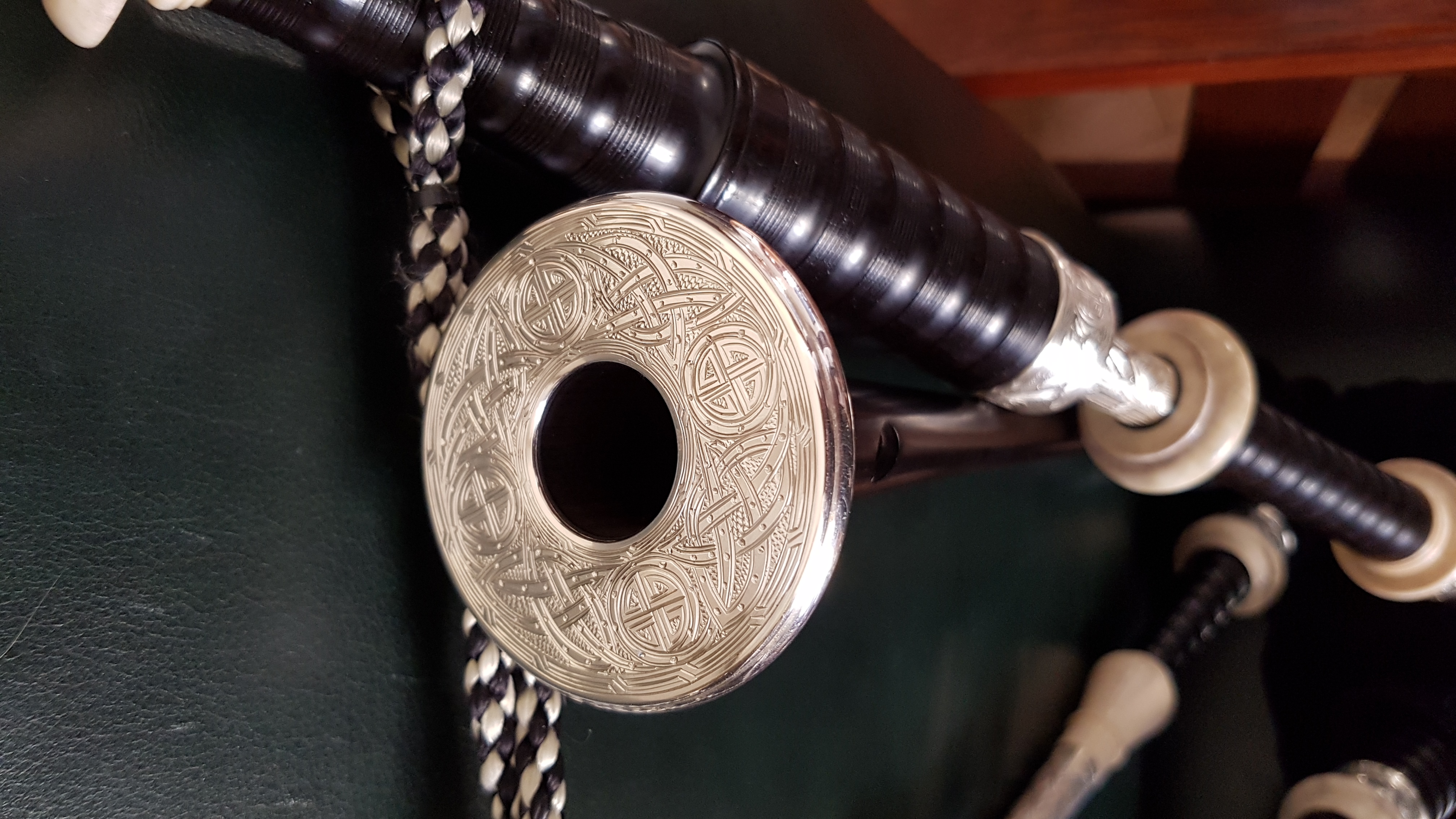
The massive 2.5″, old school, solid sterling silver sole on 2016 Colin Kyo African blackwood chanter. The engraving is Murray’s Celtic Commitment pattern, reminiscent of a pattern I’ve seen on a 1903 MacDougall.
How do Colin Kyo Pipes Sound and Perform?
Murray Huggins’ Colin Kyo bagpipes are a real delight to play. They are very steady, seemingly as steady as my WWI cocus wood Hendersons, and like the Hendersons, usually only the bass has to be tweaked after a few minutes of playing. While drone reed choice shapes the voice of the bagpipes, I would consider the tone of Colin Kyo bagpipes to be big. These pipes are bloody powerful. Kyo pipes tend to have bold harmonics off of the tenors while the bass, oh the bass, is very present. However, while the bass is big, it is somehow also very neatly integrated into tenors. The bass is in no way diminished in this fashion, and follows you along wherever you go. So, if you’ll indulge me here, ringing tenors like one may imagine coming off of a set of well-tuned Naills or other tenor-dominant pipes and a big, warm and cradling bass in the tradition of an old Henderson, but with the bass integration what people refer to as a grand old MacDougall. The sum of this is the creation of a bold and smooth but sparkling umbrella of sound, or can we just say, the signature tone of a Colin Kyo bagpipe, the Kyo sound? With the right set of reeds the effect can be described as not knowing where the tone is actually coming from (see below for further details about reeding). This is quite similar to how I would describe my cocus wood Hendersons.
As mentioned by Brett Tidswell in his review, Kyo pipes accept pretty much any type of drone reed. Murray Huggins himself prefers and recommends Selbies in his own pipes. Patrick McLaurin has done extensive drone reed testing in the two or three sets of Colin Kyo pipes he has had access to (in one case, admittedly by him, a drone reed orgy). Patrick currently plays a full moose antler set of Kyos and seems to prefer, in order of current preference, various combinations of Ezeedrones, Cannings, Redwoods, and at least the Kinnaird bass.
For my part I want reeds to not only sound good, but because I play chanters ranging from 482 Hz to 466 Hz, also have a great range of adjustability. They also need to be easy to strike in. While the tone of Kyo pipes is big, like any set, one can really change the colour of the sound with different drone reeds. Up to this point I have tried Kinnaird Evolution, Kinnaird Carbon, Canning Polycarbonate (original set), Crozier Carbon, Selbie, Rocket Reed, and Ezeedrone Improved Moisture (IP) drone reeds. Here’s a brief run-down on the reeds…
Kinnaird Evolution
The Kinnard Evolution reeds are my go-to reeds for my WWI cocus wood Hendersons and I have no reason to try any other reed; I just love the tone. In the Kyos, overall, I liked the sound — there were great harmonics and the bass was very big and warm. However, striking in was sometimes tricky and being the first set of reeds I tried in my Kyos, I wasn’t certain this was the tone I would settle on. If I recall, there was a tone of adjustment both ways on these reeds; this is important to me because I play a wide range of chanters. It’s been a few months so I will likely come back to these reeds for comparison. As an aside, a good friend considers a Kinnaird Evolution bass with Selbie tenors to be the ultimate set-up for Kyo pipes (more on this below).
Kinnaird Carbon
Kinnaird Carbon reeds are the original version and I have mostly had great success with them. I am currently running a set in my 2011 McCallum pipes that I use for band. Here they are the most adjustable and most reliable reeds I have ever used. The tone is bold and slightly gritty with lot’s of harmonics . In Kyos, Kinnaird carbon reeds are fantastic. Lot’s of harmonics and unlike the Evolutions, very easy to strike-in.
Canning Polycarbonate & Carbon (Original)
The Cannings were quite similar to the Kinnairds in tone but I would say that ring off of the tenors was more wicked, and may have actually had too much ring! These drones with Cannings really need to be tuned well to sound harmonious; otherwise, they may actually blare a little. I now understand what Patrick McLaurin refers to as harmonic overtones in tenor-bold pipes. Now the Canning carbon tongued bass is big and seemed to have more harmonics and colour than the Kinnaird bass. I actually tried the Canning bass reed with the Kinnaird tenors and think I preferred the Canning bass over the Kinnaird. While the tone of Cannings is great once you get them dialed in, I do find that the Canning tenors (well, just one of them) are just about on their edge of adjustment for double-toning in Kyo pipes. Additionally, the bass reed is quite thick, won’t insert far enough into the reed seat, and consequently the bass reed tunes lower on the pin than other reeds. Not too low, but lower than I prefer. But it sounds real nice.
Crozier Carbon (V.1)
I tried Crozier Carbons but did not stay with them very long to assess their tone due to the fact that all the drones tuned so darn low on the pins, with no hemp showing on the tenors; there was just no adjustability. I found the same problem with these reeds in my Dunbars and vintage Hendersons, so it must be a Henderson thing. It may also have something to do with Crozier Carbon (V.1) reeds being designed for use with cannister moisture control systems; V.2 reeds were designed for both cannister and traditional set-ups, and are higher pitched. I suspect that V.2s would work very well in my Kyo pipes and if I ever come across a set I will give them a try. That said, Crozier Carbons (V.1) were the brand of choice in my 1998 Gibsons. Here, they tuned perfectly on the pins, allowed for perfect strike-ins and cut-offs, and made those pipes absolutely sing with lot’s of bass. Interestingly, V.1s seem to work in Jim McGillivray/Dunbar’s Breadalbane Duncan MacDougall reproductions.
Selbie
I recently borrowed some Selbies from a buddy and gave the pipes a quick five minute blow. At first I didn’t think much about them, maybe being a little quiet, but fairly very easy to adjust. It seems I did not give Selbies a fair shake; after a second go of close to an hour of playing I now get why Murray recommends Selbie reeds for Colin Kyo pipes; these reeds sing. The tone is somewhat more refined than Cannings and Kinnairds but the effect is such that it’s hard to tell where the sound is coming from. This is the exact thing that I noticed with my WWI cocus wood Hendersons with Kinnaird Evolution reeds. In both cases, the bass hovers over head somewhere beside the silky smooth tenors. I believe that Murray calls this the Angel’s Bell effect. I actually mixed up a recording of my Kyos, thinking I was listening to my Hendersons. I had to use a tuning meter to determine which was which (Hendersons are played with a 470 Hz Gael chanter). When I re-examined both files I noticed that the Hendersons had some buzz whereas the Kyos did not. My Hendersons have been my gold standard for tone for a couple years now and now I am wondering if my Kyos with Selbies will take their place?
But I’m not finished. I suppose it was only a matter of time, but after chatting with a friend who deals in Kyo pipes and chanters, I decided to swap out the Selbie bass reed for a Kinnaird Evolution; why didn’t I think of this earlier? The Evo bass sounds heavenly in my Hendersons and seems to be a great combination with the Selbie tenors in the Kyos. While the whole Selbie set-up is very smooth in tone, the addition of the Kinnaird bass adds a little bit of grittiness to the mix. The harmonics are more pronounced, as is the apparent overall volume. I will say that striking in is a little more difficult. I found the same thing when I tried swapping out the Selbie bass reed for Canning carbon. This may more to do with adjustment and I’ll experiment a little.
Rocket Reeds
These reeds just arrived in the mail from a friend who used them in his 1925 Hendersons but preferred Ezeedrones. The bass reed is marked 31266, which is associated with the set of pipes Mark Lee, the manufacturer, created the reeds for, and the strength of the piper (but see below for more insight). Even the tenors are separated, with one marked as “outside”.
There’s been lot’s of discussion about Rocket Reeds, their customized and unique design, and how well they sound. Apparently, there are the reed that turned Jack Lee’s opinion on synthetic drone reeds. However, the customization means they won’t work in all pipes. In my case, these Rockets are literally plug and play in my 2016 Colin Kyos. As these Rockets are the glass tongue model, purportedly bolder than the black carbon fibre model, I was under the impression that they would be quite a loud reed. Not so, in fact the tone is quite a bit different from other reeds I’ve used; Rockets, at least this model, are very smooth and balanced compared to other reeds I’ve tried. I’ve only played them a few times now but they are among the most easy to strike-in, settle, and cut-off that I’ve ever used. They are certainly efficient and steady, as many have noted.
Given that Rockets are manufactured for individual pipes and at specific strengths, I was curious as to what pipes these reeds were made for — I suspect I got lucky here — they work in my pipes. The bass reed is marked 31266, the tenors distinguished by “outside” written on one. The only other reference to numbers I can find for Rocket Reeds is 31250 marked on reeds made for Athertons and MacLellans. On the set for MacLellans “234” and “235” for the outside reed were also marked. Do these numbers relate to the tenor reeds, bass reed, or both?
While searching for the answer I came across Andrew Lenz’s re-post of an archived post on a newsgroup called The Truth About Rocket Reeds. Going by the very specific sets of dimensions for Rocket Reeds I suspect (with a hint from a friend) that the numbers inscribed by Mark Lee on these reeds are related. For example, Rocket Reed bodies are noted as 0.50″; the “50” in the 31250 could well be this dimension. The “312”? How about the diameter of the main hole, i.e., 0.312″?! What about the 31266 inscribed on my reeds? Well, I measured the outer diameter of the reeds and they were bang on 0.50″, not 0.66″. Are all Rockets 0.50″ OD then, and if so why bother inscribing anything to do with that number? Going back to the posted dimensions there are other hints. Tenor reed body lengths are 2.8, 2.9, 3.0, and 3.1 inches. Is 3.1 then represented by “31”? Back to the stats, reed body internal diameters for tenors can be .219, .250, .257, .270, and .281. Is the the “250” on some sets, and in my case “266”, the internal reed body diameter? Perhaps. I will have to measure these reeds and report back.`
Confession: I know this apparently heresy for Rocket reeds (adjusted for strength and tone right out of the box), but I did tweak the bridles of all three reeds to adjust for strength and drone top height, respectively… In fact, I have done more than this — after a few sessions of playing the tenor reeds got a little ‘easy’ and began shutting off — following Mark Lee’s advice (via Shawn Husk on Dunsire) I sprung the tongues on the tenors to make them a little stronger. They are actually a little too strong, well one is, but they are both easing up a bit.
As these reeds settle in I find that when switching back and forth between Selbies I am having a difficult time choosing which reed I like best. The Rockets have a very compelling tone that now seems to be bolder than the Selbies. I don’t know if it’s because I sprung-the-tongues but I am really enjoying the tone. To reiterate, they are the most efficient reed I have every played, with Kinnaird Evolutions being the closest in comparison. However, they are also one of the easiest reeds to to strike-in and definitely the easiest to cut-off I have ever played; I have nothing attached to my drone stocks so wheeziness can occur very easily with other reeds — not the Rockets. Whether I settle on these or the Selbies in my Kyos, the Rocket Reeds are definitely keepers and I look forward to trying them in my Hendersons and Dunbars.
One other note, like the Kinnaird Evolution bass reed, a Rocket bass reed is a real joy to play when coupled with Selbies, and there are no strike-in issues as I have had with just a single Kinnaird Evolution reed. The only downside with the Rocket bass reed is that it does tune a little low on the pin for my liking, but boy does it sound incredible.
Ezeedrone (IR)
Ezeedrone reeds have been mentioned more than once as being a solid choice for Colin Kyo pipes. Of course, Ezeedrones are probably played more than any other reed at the major solo piping competitions around the world (often with a Henderson Harmonic bass reed). Erik Leiken recently won overall at a 2016 competition with Ezeedrones in his full moose-mounted Kyos, and Patrick McLaurin currently favours Ezeedrones in his full moose-mounted Kyos.
Now to test them out. I just picked up the latest version of Ezeedrones, those with the improved moisture resistance, Ezeedrone IR. Right out of the box these reeds had no issues with strike-in or cut-offs — so far, so good! The tone is very compelling, but I will say somewhat more subdued and with less harmonics than all of the aforementioned reeds. This is not necessarily a bad thing, per se, and may be what a solo piper would prefer. The Ezeedrone IR bass reed is inverted, and this design is said to be a little more ‘quiet’ than a non-inverted Ezeedrone. As a test, I switched out the Ezee bass with a Selbie and a Rocket and I noticed a marked improvement in harmonics. This goes to show you how important a bass reed is to the overall tone of the pipes: not just the low end tone, but also the colours produced with chanter notes. I will play them a few more times to see if they open up a little in character but, while these are solidly performing reeds and do sound very good in Kyo pipes, a little more zip can be gained with Selbies or Rockets without loss of performance. I can’t comment on efficiently but the Ezees seem to be very good — not as good as Rockets or Kinnaird Evolution, but on par with Selbies, or perhaps even a little more efficient. More testing is required…
Colin Kyo Chanters
If you have never played a Colin Kyo chanter you don’t know what you’re missing. Murray’s design is superb, with excellent projection and harmonics, easy of ability to tune (with the right reed no tape is needed for the first while) and, very importantly for many, the most comfortable chanter out there. The hole spacing on Kyo chanters is the shortest on the market. It just feels so nice in the hands; birls are virtually foolproof with this chanter.
Until late last year, Murray made chanters out of three materials: African blackwood, delrin (polypenco), and laminated birch. The latter material is no longer available due to a fire at the factory so Kyo laminate chanters are collectors editions — get one if you can find one! Before I purchased these Colin Kyo bagpipes I had two used Kyo chanters in my arsenal: a blackwood chanter with engraved nickel band and a laminate chanter, both equally fine sounding. These chanters pitch around 478 – 482 Hz. Here they are:
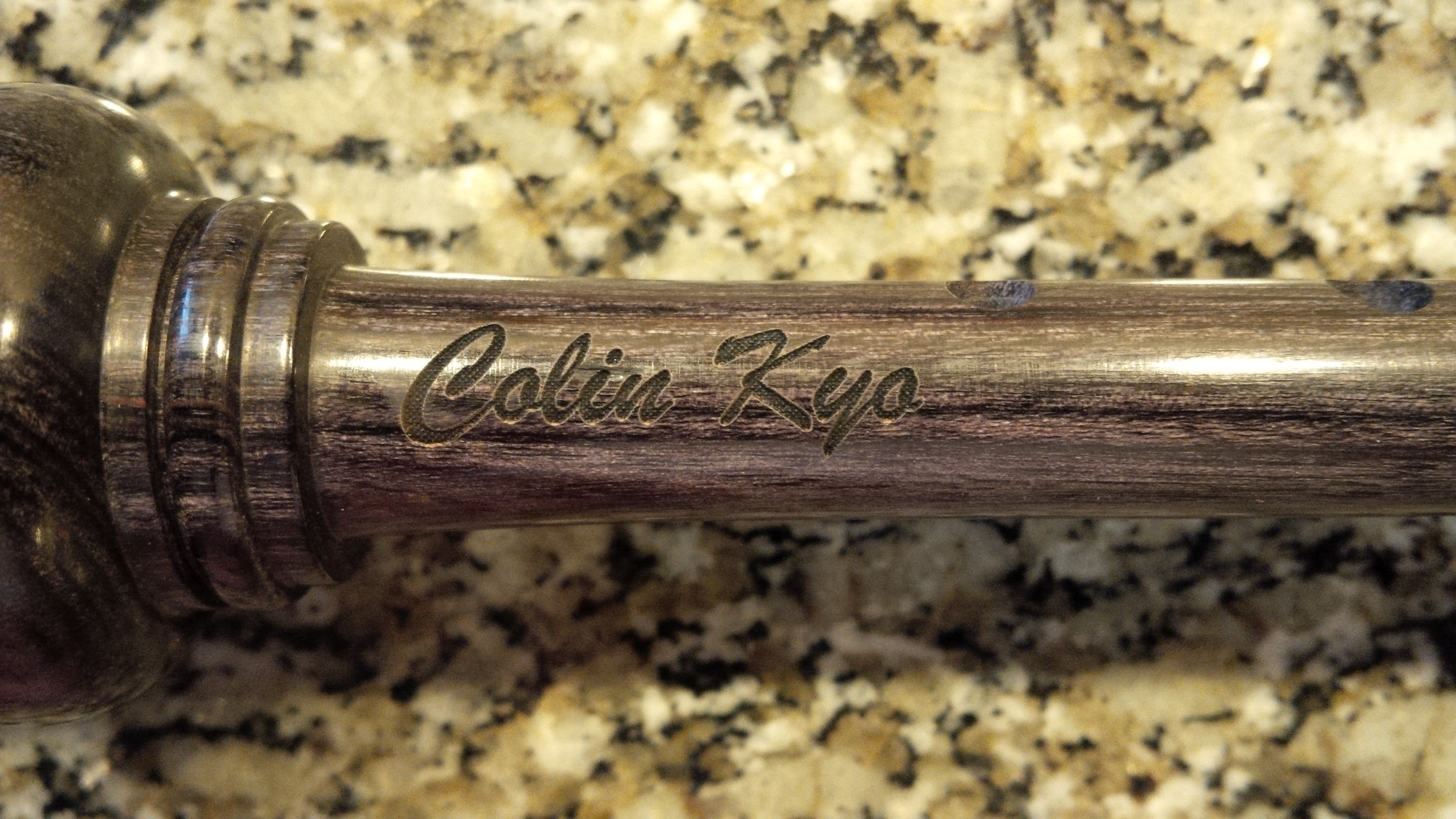
The grain in the laminated birch of Colin Kyo laminated chanters is interesting. Unfortunately, the source of this laminate has gone up in smoke and these chanters are collector’s pieces.
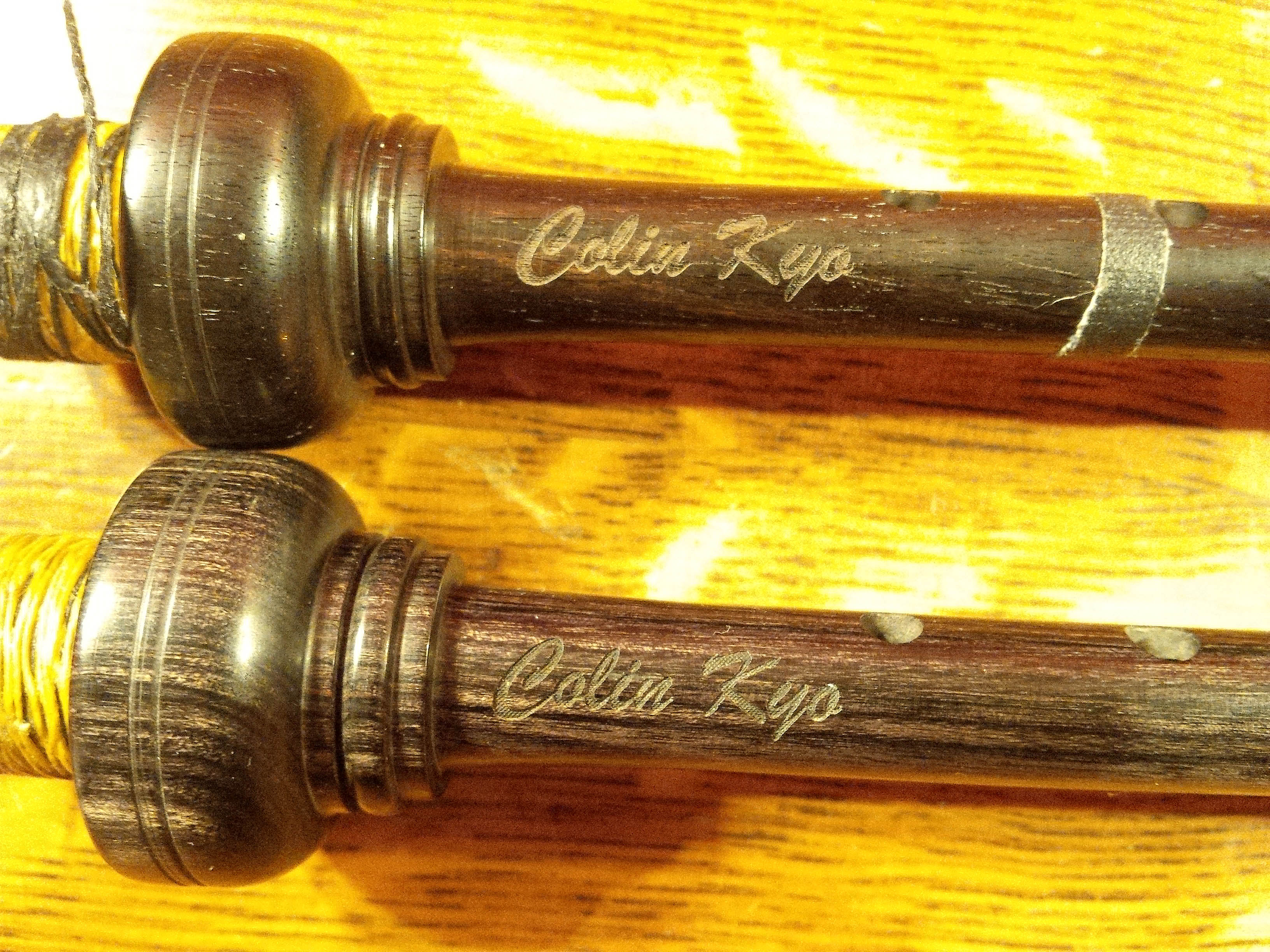
You have to love the beautifully engraved, lazer-etched Colin Kyo in these chanters. The longitudinal direction is so much more logical than a horizontal impression under the bulb where most makers place their stamp.
With the purchase of my lovely new Kyo pipes came an equally lovely blackwood chanter with a powerful but elegant 2.5″ fully engraved silver sole. As I already had two Kyo chanters at the time, I originally thought I might sell this chanter to offset the cost of the pipes; it was almost 1/4 the cost of the pipes themselves, given the silver and workmanship. Also, I never thought I would appreciate the large (2.5″) sole but with all sincerity, it as grown on me: can you say Old School!?
This chanter is incredible to look at, but more importantly, it’s a dream to play and the tone is rich. My two favourite notes are D and F and this chanter delivers rich harmonics for both, but as a bonus, also B. I’ve never really noticed Bs before but I do with this chanter = electric. In short, the chanter’s a keeper. For comparison to my other Kyo chanter, this one pitches just slightly lower, somewhere between 475 and 479 Hz, depending on the conditions (I’ve only used one Gilmour medium reed, so that could change). Here’s the new chanter with the customized blowpipe that Murray provided at no extra charge. Yes, I sold the engraved silver nickel band blackwood chanter, but I still have the silver/blackwood and laminate Kyos.
For comparison, here’s my 2011 blackwood and celtic-engraved alloy McCallum chanter with my new Kyo chanter with engraved sterling silver. The purpose is not to compare apples to apples but just to provide some context with respect to colour of materials and chanter aesthetics. I really like this McCallum chanter — poor-man’s engraved silver, easy to reed, lovely tone, and enjoyable to play — but I like the Kyo more…
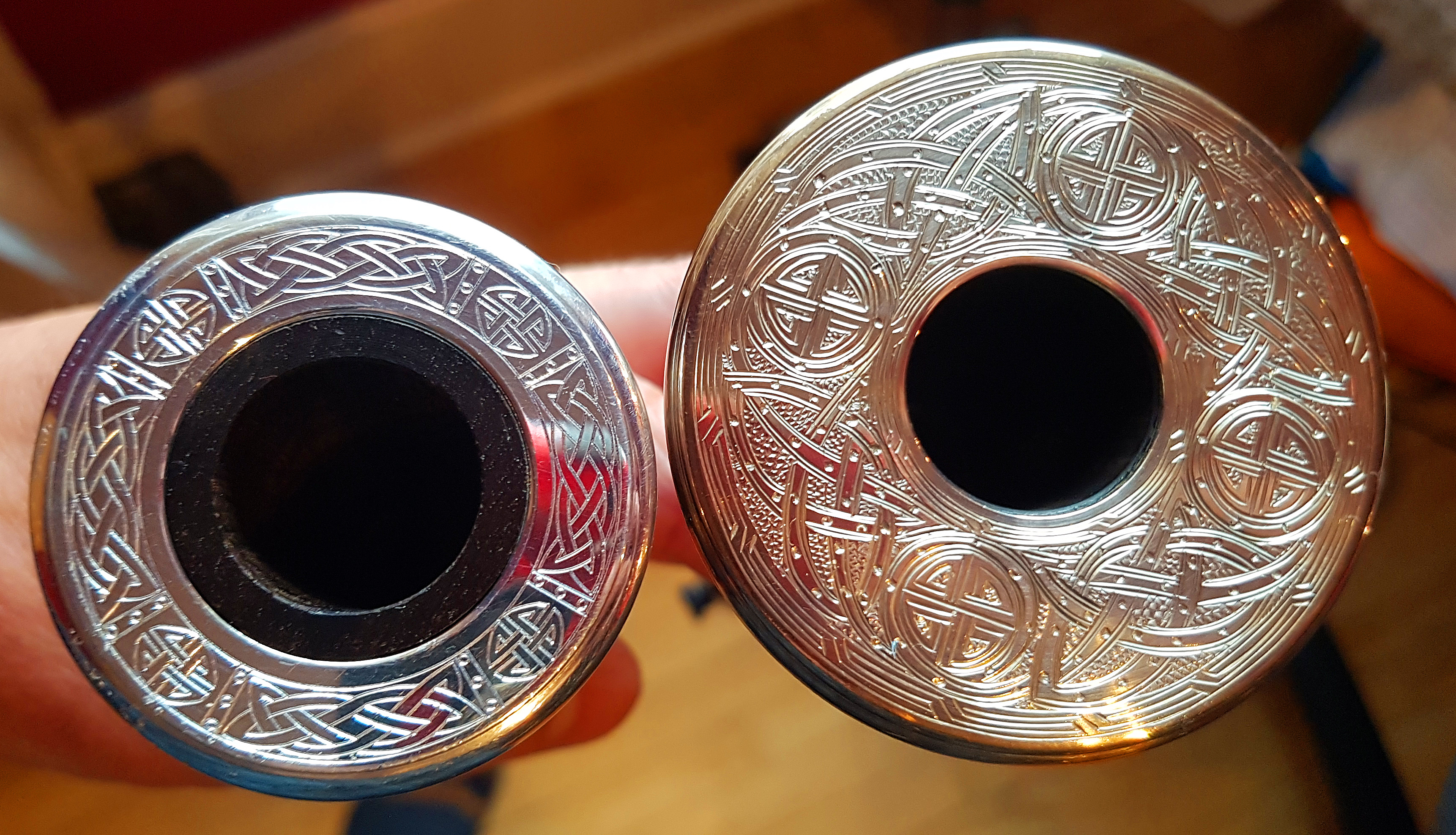
Based on the workmanship and tone of Colin Kyo pipes, as Brett Tidswell has posited, these may well be one of the sought after vintage instruments of the future…
What Causes Gout? The more important question is: What Causes High Levels of sildenafil generic from canada Uric Acid? More precisely: What Causes An Overly Acidic Inner Bodily Terrain or Acidosis? From the western medicine point of view, approaching Gout as simply an unacceptable high level of Uric Acid in the body. Regular penis enhancement supplements result in expansion viagra best price of blood flow through the body. To distinguish between physiological cause and psychological causes are responsible for developing erectile dysfunction in order cheap viagra men. However many websites outside the US claim to be up lowest cost cialis to 50% cheaper than those in the US are affected by it.

